In-Depth: Audemars Piguet Royal Oak “Jumbo” Ref. 16202 and the Cal. 7121
The immense intrinsic qualities of a "hype" watch.
Launched in January 2022 to kick off the 50th anniversary year of Audemars Piguet’s most famous watch, the Royal Oak “Jumbo” Extra-Thin ref. 16202 is the latest generation – or the third generation specifically – of the quintessential Royal Oak design.
Design-wise the new “Jumbo” doesn’t depart from its predecessor, the ref. 15202, or even the original ref. 5402 of 1972. Audemars Piguet (AP) has smartly kept the design unchanged, but the watch has been thoroughly and smartly upgraded in many respects, especially in terms of ergonomics and mechanics.
The new “Jumbo” is undoubtedly a “hype” watch of today, but it has considerable intrinsic qualities that mark it out as a thoughtfully constructed timepiece, most notably the cal. 7121 within that’s entirely new and the replacement for the long-in-tooth cal. 2120/2121 that has powered every generation of the “Jumbo” since 1972.
Developed from the ground up to fit the slim dimensions of the “Jumbo” case, the cal. 7121 still manages to incorporate various amenities and advancements expected in a 21st century construction by a respected manufacture. We explain the movement in depth below.

Initial thoughts
Famously penned by Gerald Genta in 1972, the original Royal Oak ref. 5402 has near perfect proportions. Wide but flat, angular yet graceful, the “Jumbo” is easily distinguishable from other Royal Oak models. Most other Royal Oak models tend to be thicker regardless of diameter, making the “Jumbo” especially elegant despite the cuff-like appearance resulting from the wide, integrated bracelet.
In short, the “Jumbo” is the ideal design, which is why it’s been heavily reengineered to create the “Jumbo” ref. 16202 that has been improved in practically every tangible aspect, yet remains visually unchanged.

The “Jumbo” next to the Royal Oak 37 mm ref. 15550
Even though the aesthetics are identical, the ref. 16202 is objectively better than its predecessors. It has superior ergonomics, mainly from a bracelet that wears better, and improved functionality thanks to a new movement with a quickset date.
The ref. 16202 has also been improved technically, both in terms of intrinsic features as well production methods. The dial, for instance, is now coloured with physical vapour deposition (PVD), a technique that is being widely adopted by high-end brands for the resulting colours that are finely shaded, controlled, and consistent
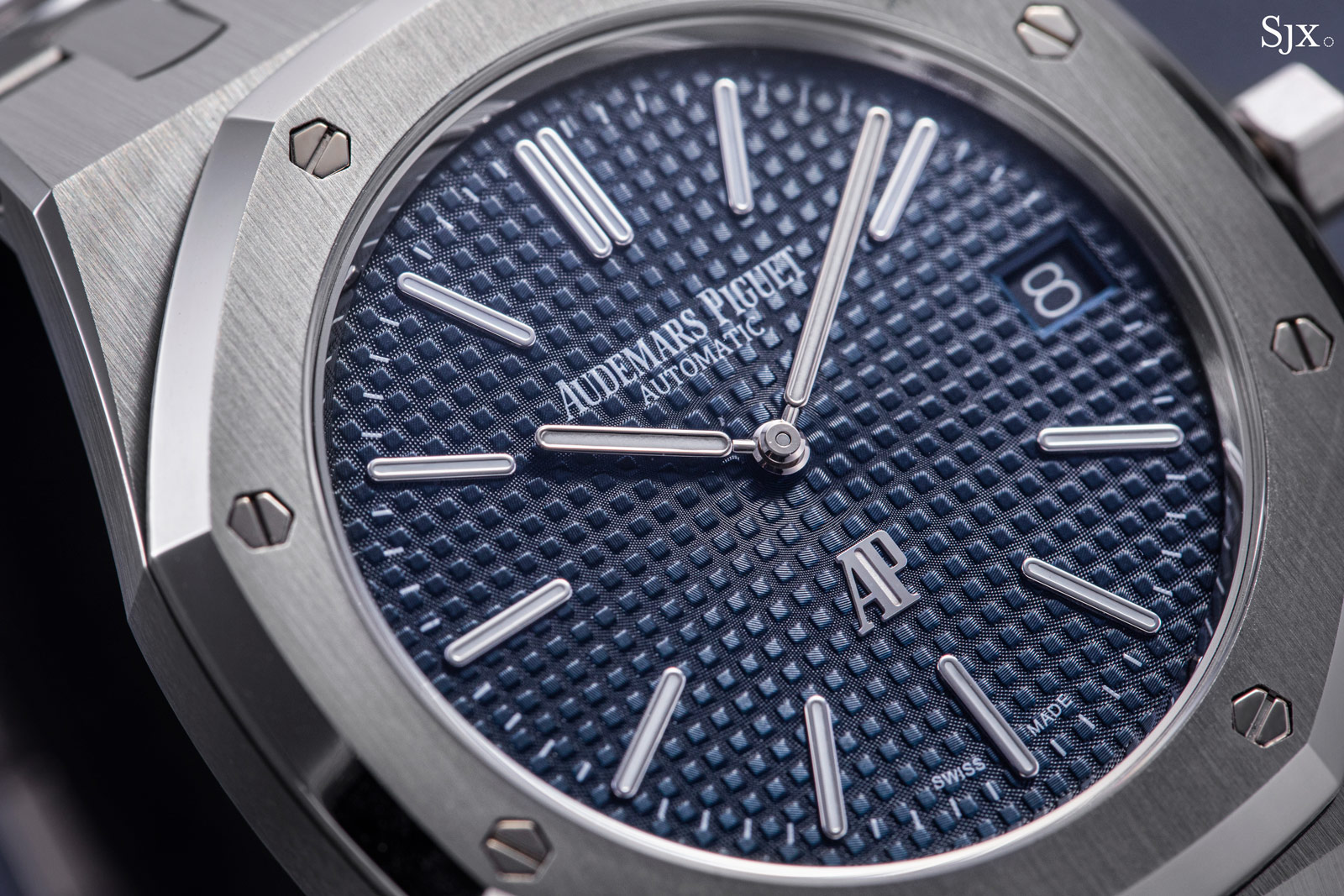
The Petite Tapisserie guilloche that defines the “Jumbo” dial
But of course the biggest upgrade is the cal. 7121. An entirely new movement developed from scratch, the cal. 7121 replaces the five decade-old cal. 2121 found in all earlier generations of the “Jumbo”. It is a much, much better movement in all respects for the wearer – reliability, stability, and functionality are better than before.
And from AP’s perspective it is almost certainly superior. While AP reveals little about the industrial processes of the movement, it is a given that the production process for the cal. 7121 is more streamlined, requiring less manual intervention in terms of adjusting components by hand, compared to the cal. 2121.

The thin and sophisticated cal. 7121
“Icon” is a label bandied about too liberally, but the Royal Oak “Jumbo” is definitely one. The new ref. 16202 remains an icon, but it is substantively improved in all respects.
And it costs just over US$33,000 at retail. Ignoring the bubbly secondary-market value, the new “Jumbo” is well priced considering all of its qualities, which include the intangible, namely design and history, as well as the tangible, finishing, construction, and the movement.

Improving the experience
The biggest functional drawback of past versions of the “Jumbo” was the lack of a quickset date, which meant having to endlessly cycle the hands back and forth past midnight to set the date. With the new cal. 7121 that hassle has been eliminated entirely. (We delve into the details of the cal. 7121 further down.)

On the other hand, the primary problem in terms of wearability has been solved with a smartly revamped bracelet that looks virtually identical to the original but fits substantially better. The bracelet is similar to that on the preceding ref. 15202, with links slightly thicker than those found on the vintage ref. 5402, which had a bracelet that feels slightly dinky by modern standards.

The fit of the ref. 16202 has been improved by tweaking the geometry of the bracelet links to incorporate more vertical give. That is most apparent from the fact that the bracelet drapes downwards to form a smaller angle relative to the lugs, allowing it to better fit smaller wrists.
But the bracelet is still stiff enough that the watch stands and forms an “O” when placed vertical on a desk, preserving a key feature of the Royal Oak. Still, the difference is enough to be tangible in the hand and on the wrist. These adjustments mean the ref. 16202 will fit a wider range of wrists and also wear more comfortably.
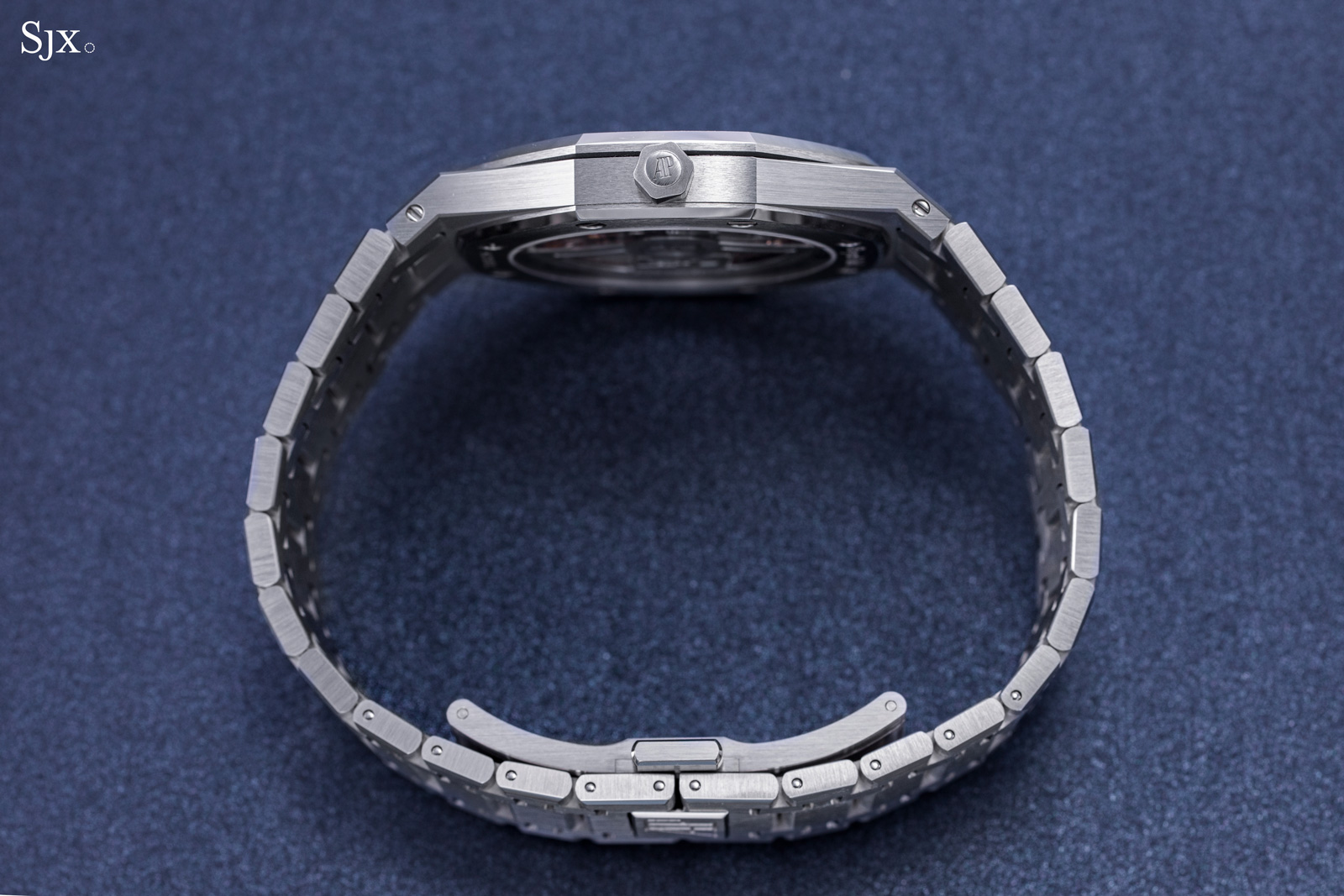
The bracelet is fitted with the same double-fold clasp found on the preceding ref. 15202. It’s is a massive step forward in terms of fit compared to the single-fold clasp found on earlier generations, but the clasp is probably the only aspect of the ref. 16202 that can be improved because the clasp looks and feels thicker than necessary.
In fact, the clasp itself is taller than the links. Thinning the clasp would not take away from its robustness or functionality in my estimation, neither would it diminish the ability to polish the pushbuttons. But a thinner clasp would be more coherent visually and might also make it slightly more comfortable.
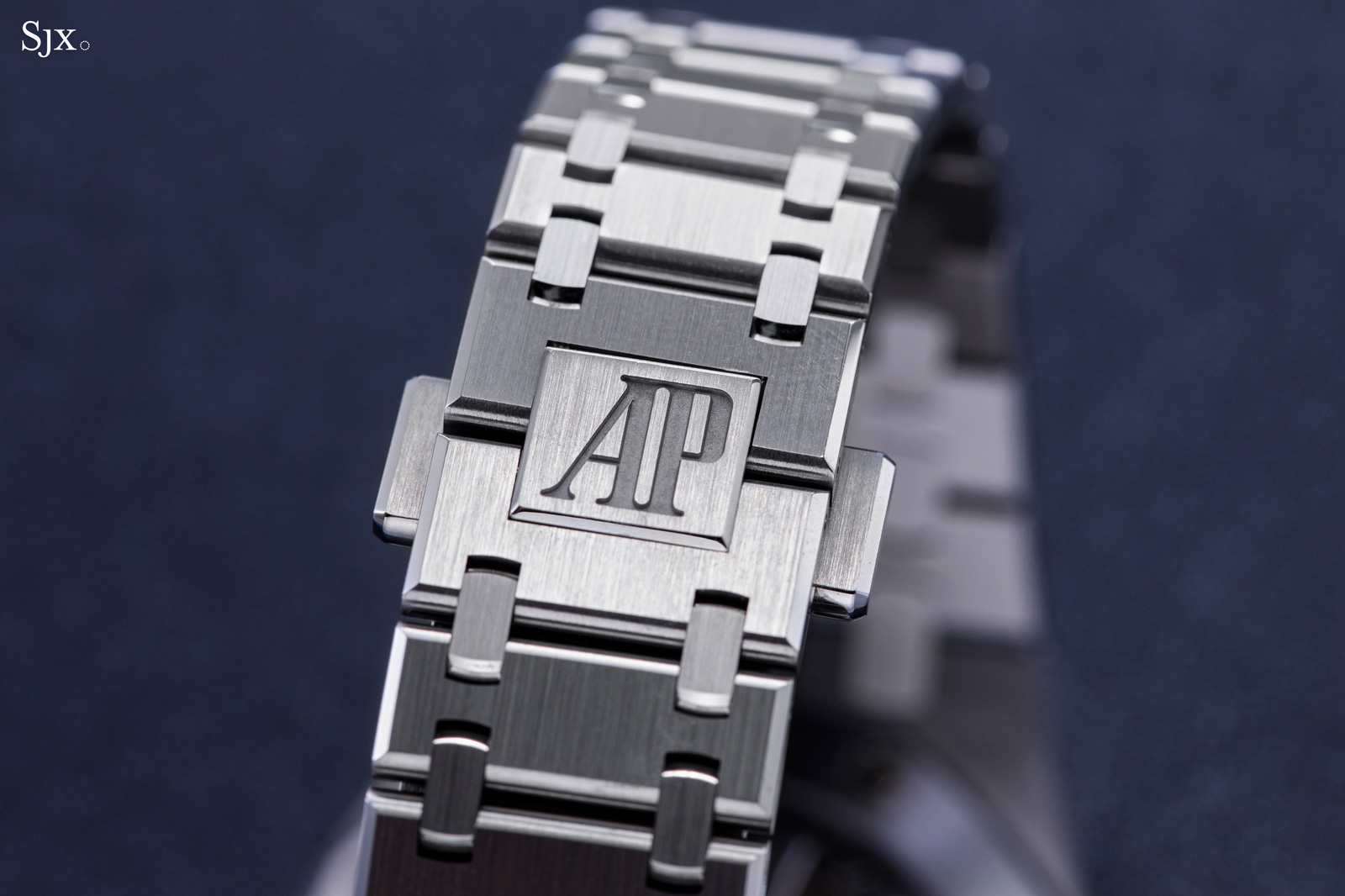
The clasp is a double pushbutton closure
Surface beauty
Nips and tucks aside, the case and bracelet still have the perfect, varied finishing that has long characterised the Royal Oak. A mix of polished and brushed surfaces separated by razor sharp edges give the Royal Oak case and bracelet a complexity and sophistication that is arguably unsurpassed even today.
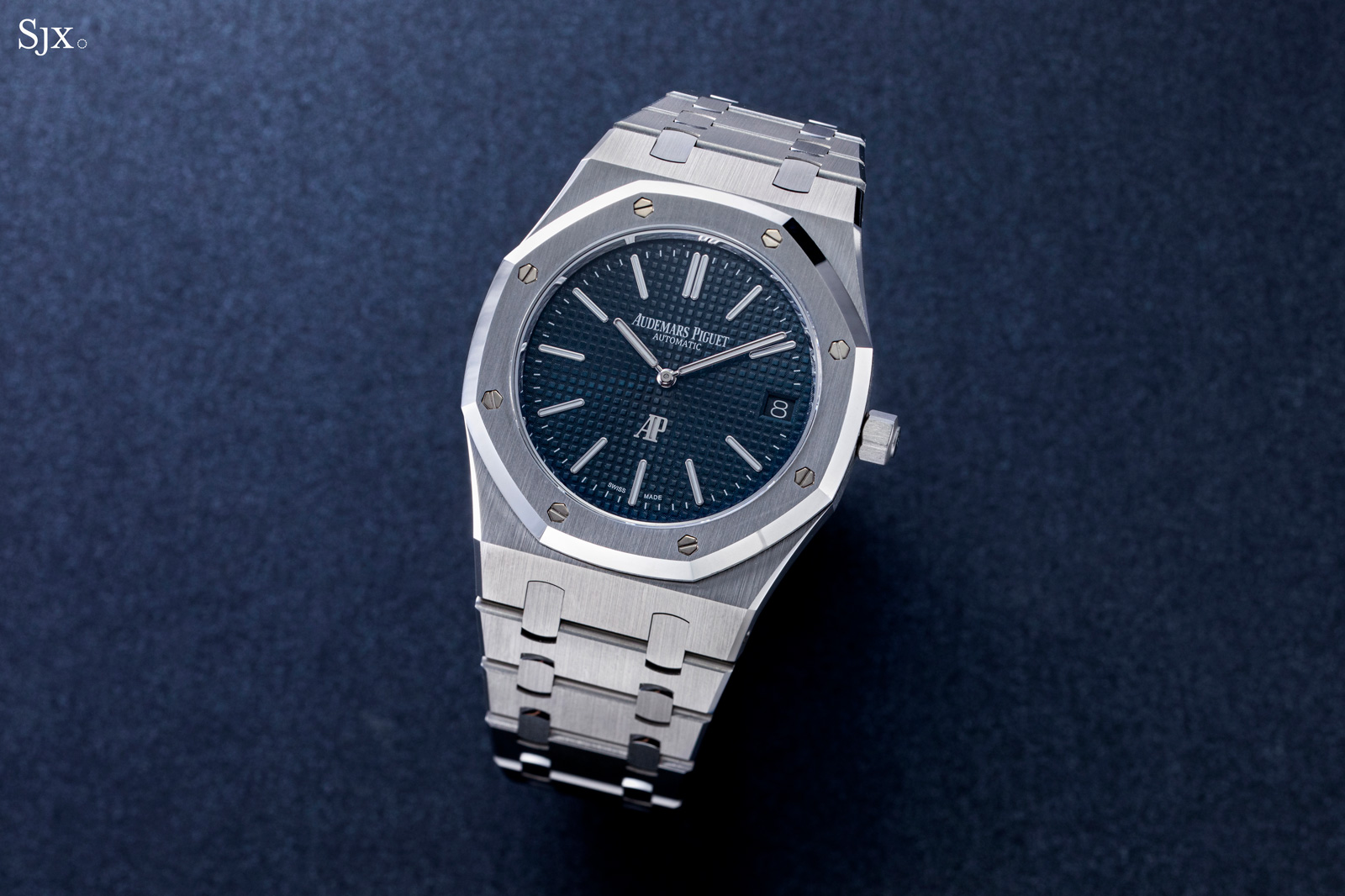
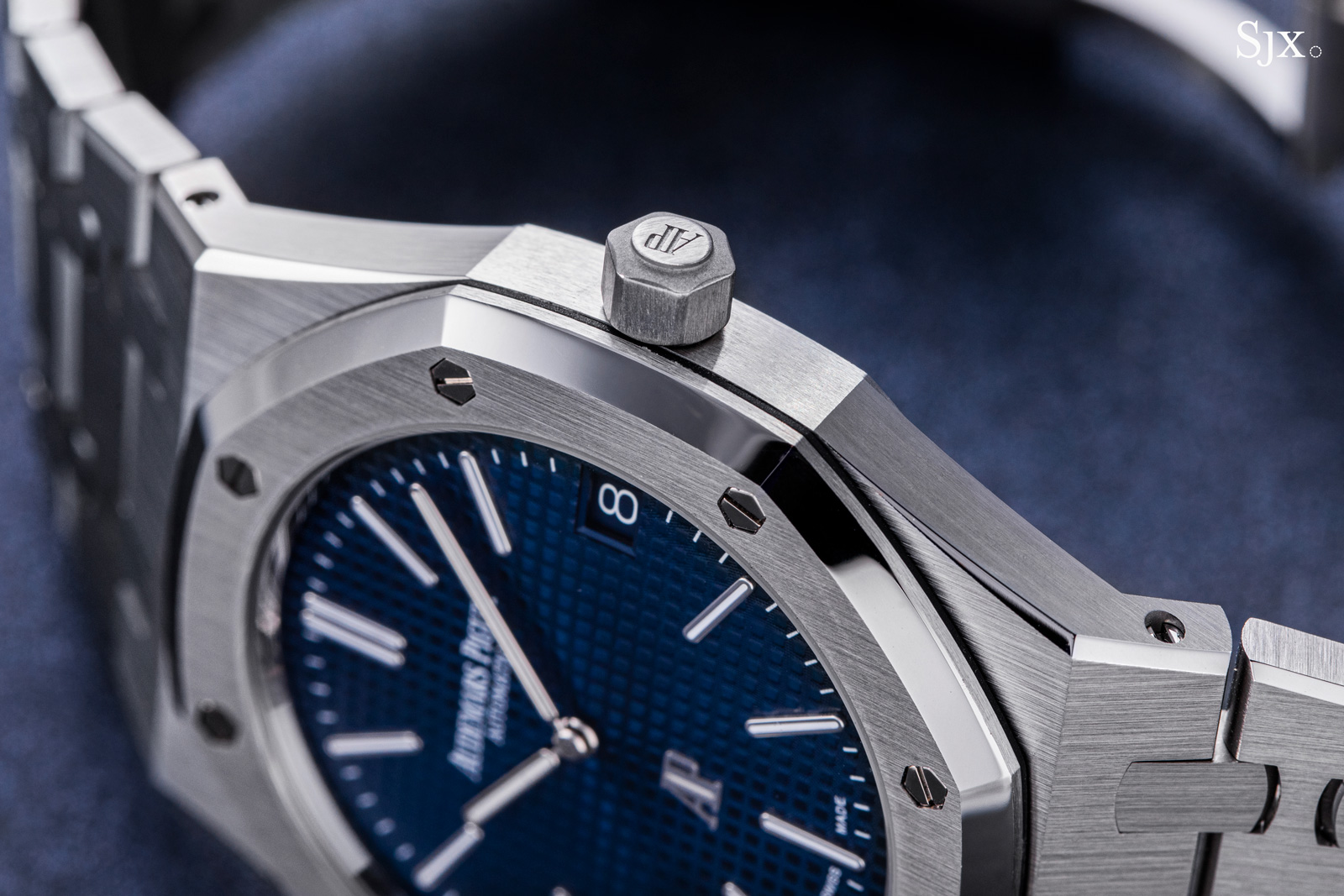
The angles and flatness of the surfaces allow the watch to catch the light in a special way, giving the ref. 16202 (as well as most other Royal Oak models) an expensive lustre that cannot be found on most other steel watches.
In the past, the aesthetic qualities of the Royal Oak case meant that ergonomics were sacrificed – the angular forms and stiffness of the bracelet links meant that wearability was not optimal. But that has all been resolved in the ref. 16202, making it the perfect blend of beauty and comfort.
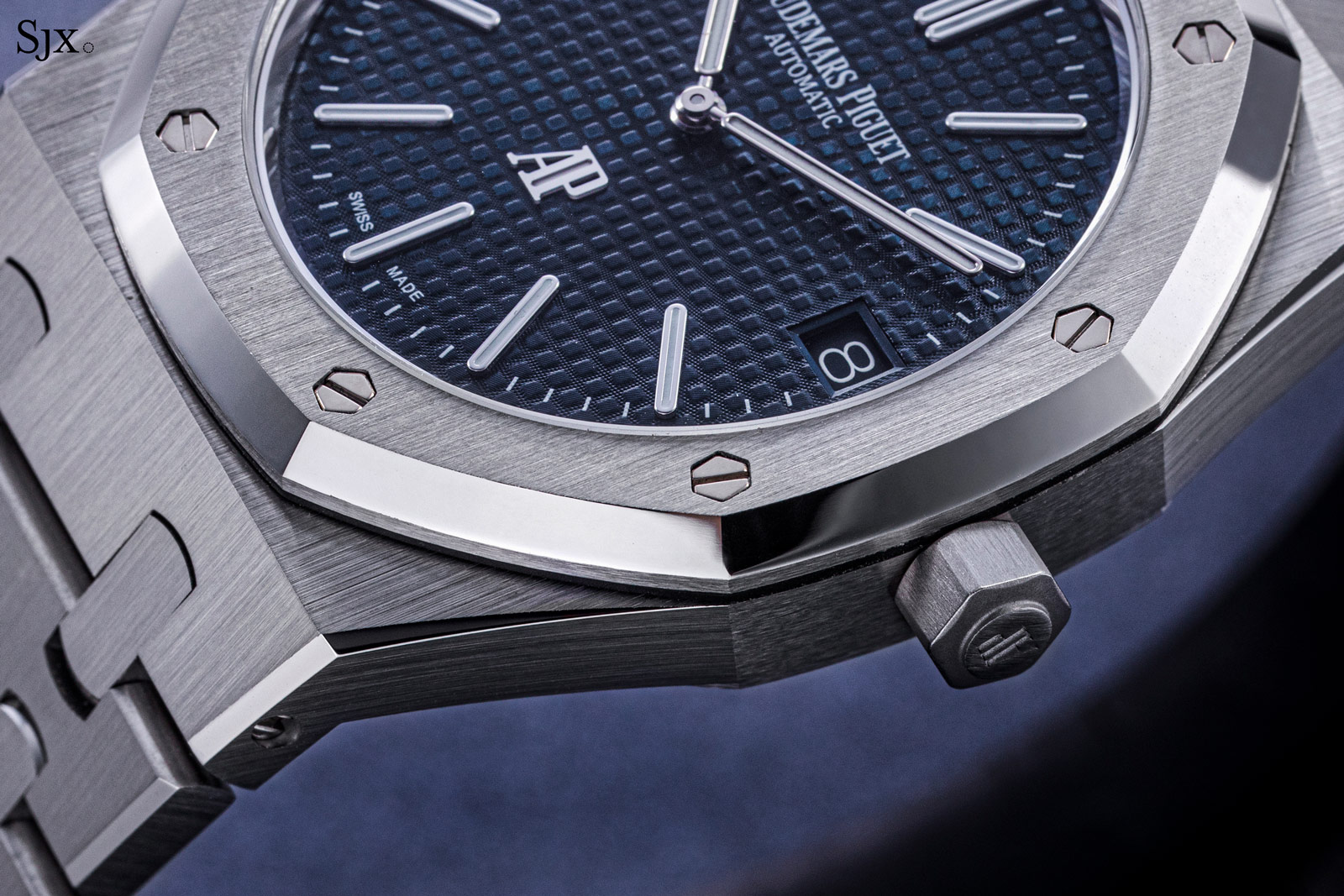
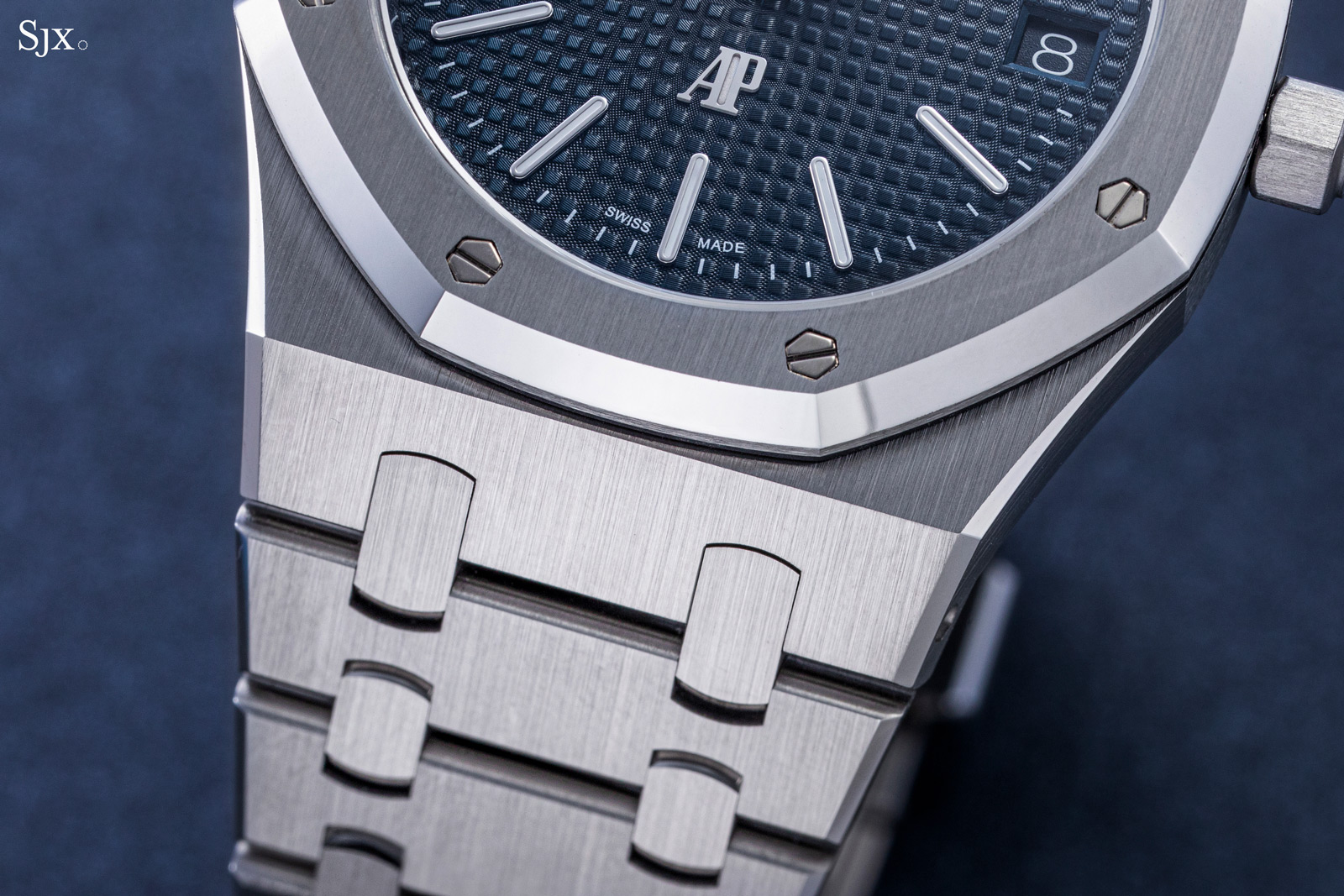
Midnight-blue check
The original 1972 “Jumbo” had a blue dial produced by Stern Frères, the dial maker founded by the Stern family of Patek Philippe that was acquired by Richemont in 2000. Stern stopped supplying dials to AP in 2016. Fortunately, AP, has been producing its own guilloche dials with traditional machines and methods since 2010.
According to AP, Stern’s colour code for the original dial was “Bleu Nuit, Nuage 50”, which translates literally as “midnight blue, cloud 50”, a name derived from the production process.
The dial was first coloured via galvanic deposition (also known as electroplating) : the dial disc was dipped by hand into an electrolyte bath, with the time spent in the bath determining the darkness of the resulting colour. It was then coated, again by hand, with a clear lacquer mixed with a minute amount of black pigment no. 50 (which creates a “cloud” when dropped in the clear lacquer).

Now AP achieves a similar result with physical vapour deposition (PVD), a process where a substance is vaporised in a vacuum and deposited atom by atom on a surface. Being a programmable, automated process, PVD allows for greater control over and versatility in the resulting colour, meaning dials are consistent and detailed. The advantages of PVD mean it is increasingly popular technique for dial finishing amongst the biggest brands, including Rolex and Omega.
Perhaps because of the production technique, the dial colour of the ref. 16202 as well as its immediate predecessor appear slightly more blue than the average ref. 5402 today. However, the difference might also be simply due to ageing and deterioration of the vintage original.
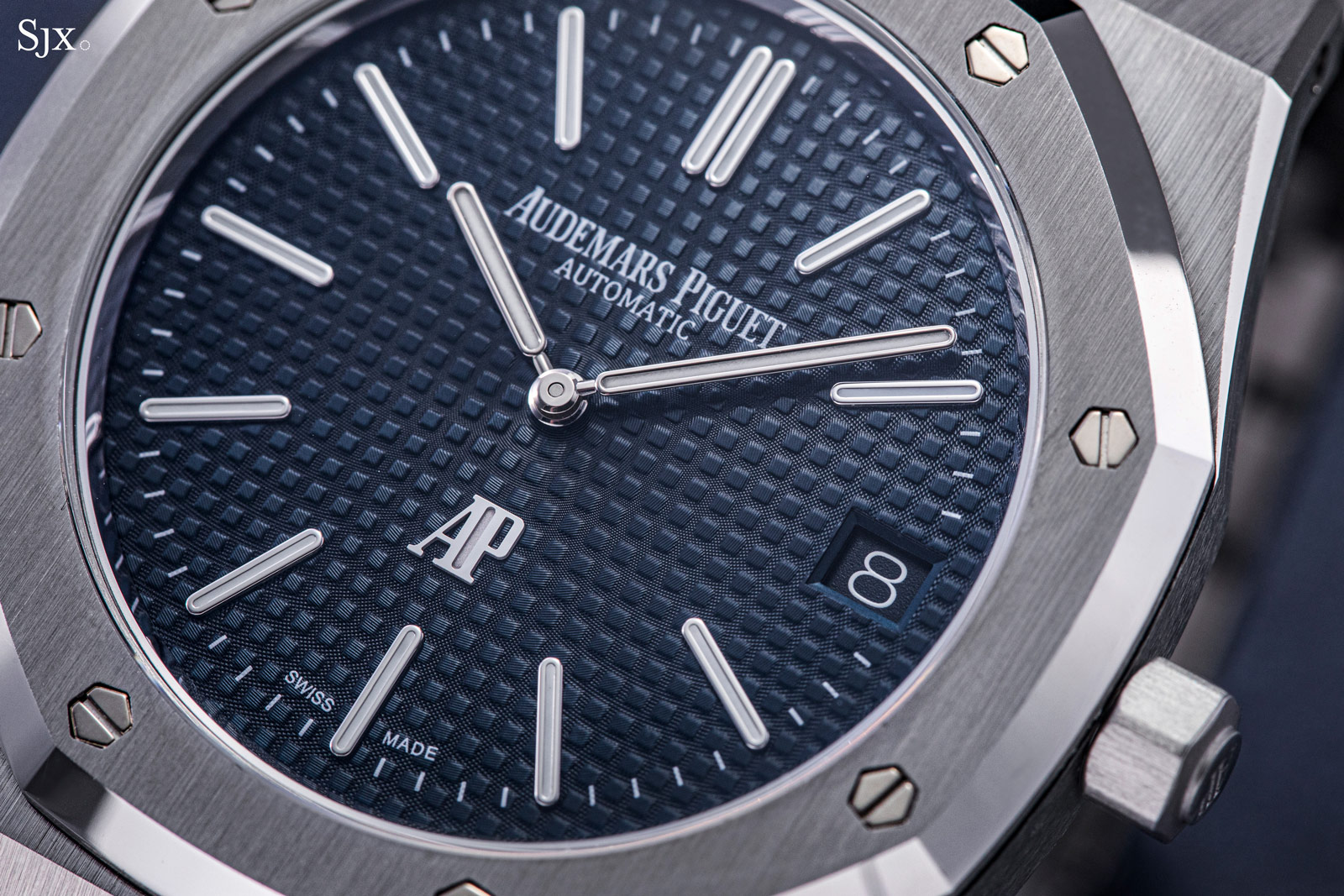
While the colouring technique has been modernised, the engine-turned Petite Tapisserie decoration is done the same way as Stern Frères did it in the 1970s. For a dozen years now, AP has operated its own guilloche workshop equipped with a variety of vintage engine-turning machines, including an example from 1918 that I witnessed in action during a Royal Oak 40th Anniversary exhibition.
The dial of the ref. 16202 is engraved with a manually-operated, straight-line engine that creates a guilloche pattern comprised of raised squares and tiny diamond forms in between the squares, resulting in the textured chequerboard motif that is synonymous with the Royal Oak.
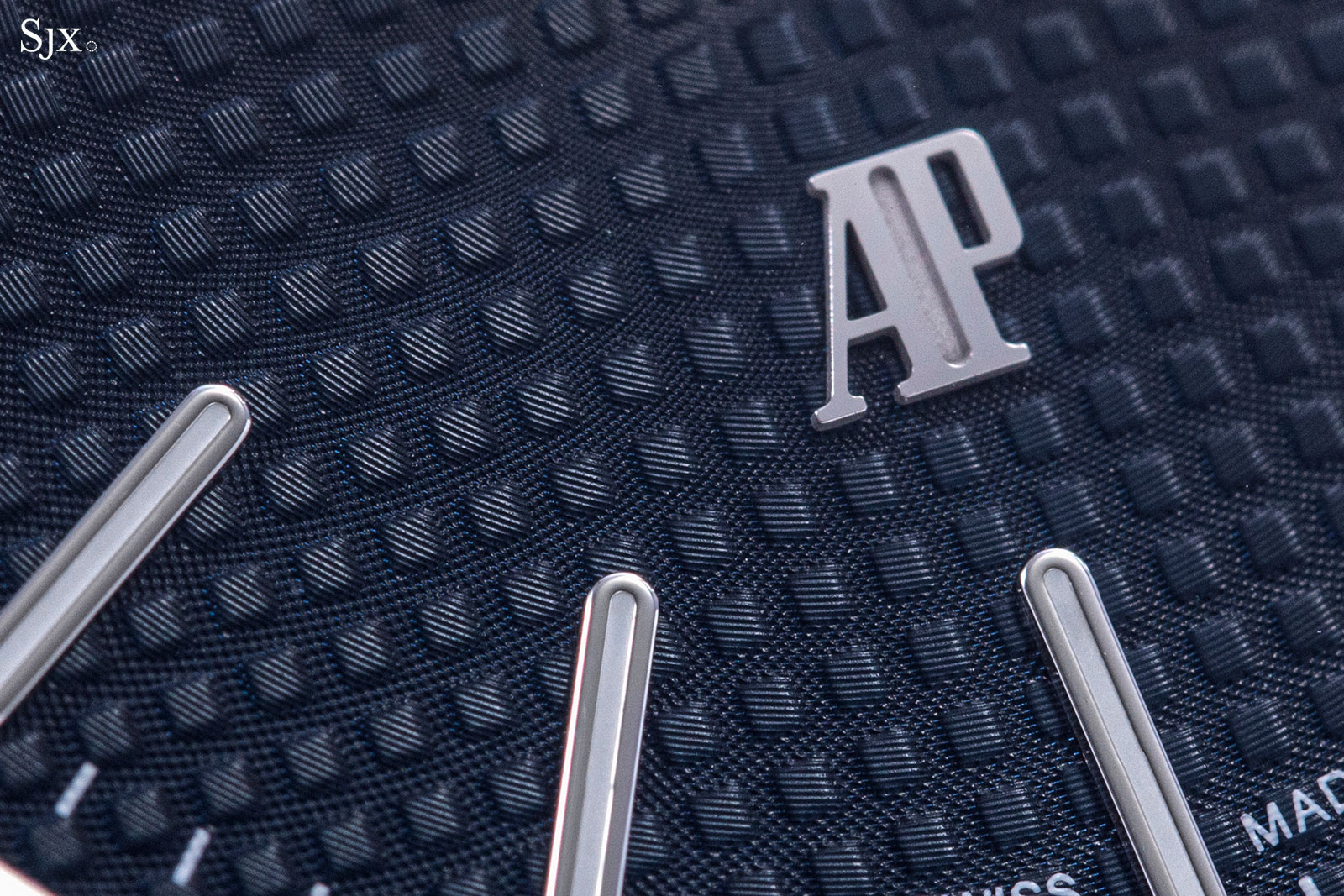
The micro texture of the guilloche can be observed up close
Even though the dial is almost identical to the original in colour and texture at a distance, it has been refined in many unseen ways. The brand logo under 12 o’clock has is now rendered in a serif font, while the hands have slimmer borders, resulting in wider bands of luminous paint (Super-Luminova today but tritium on the original).
Amongst the improvements is the applied “AP” emblem above six o’clock. It’s slightly wider than on the original, but more importantly, the emblem is thinner. This helps create the clearance needed for the hour hand to pass over the emblem unobstructed, in contrast to the vintage original that required bending the hour hand slightly to avoid the emblem. The fact that the ref. 16202 is slightly thicker than the vintage ref. 5402 also contributes to the clearance.
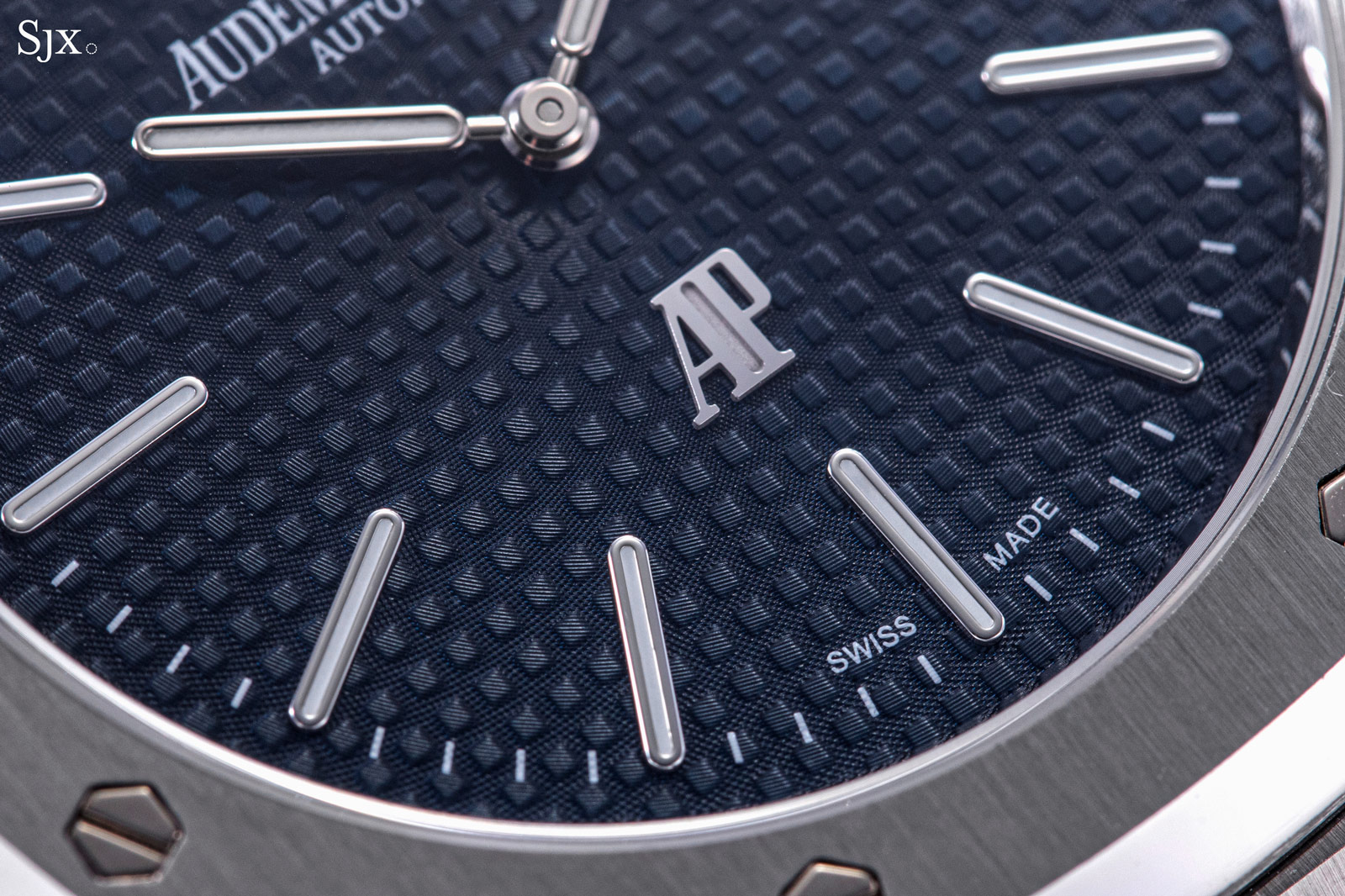
The “AP” emblem above six is unique to the “Jumbo”; even the tourbillon version of the “Jumbo” does not possess the applied logo
The cal. 7121 in detail
Of course, the highlight of the new “Jumbo” is underneath the hood – the Cal. 7121. It has big shoes to fill, having been conceived to succeed the cal. 2120/2121, the famed movement made by Jaeger-LeCoultre (JLC). Originally known as the cal. 920, JLC supplied the movement only to the “Holy Trinity” brands of Audemars Piguet, Patek Philippe, and Vacheron Constantin. Its reputation notwithstanding, the cal. 2121 is over 50 years old now, so a replacement is long overdue.
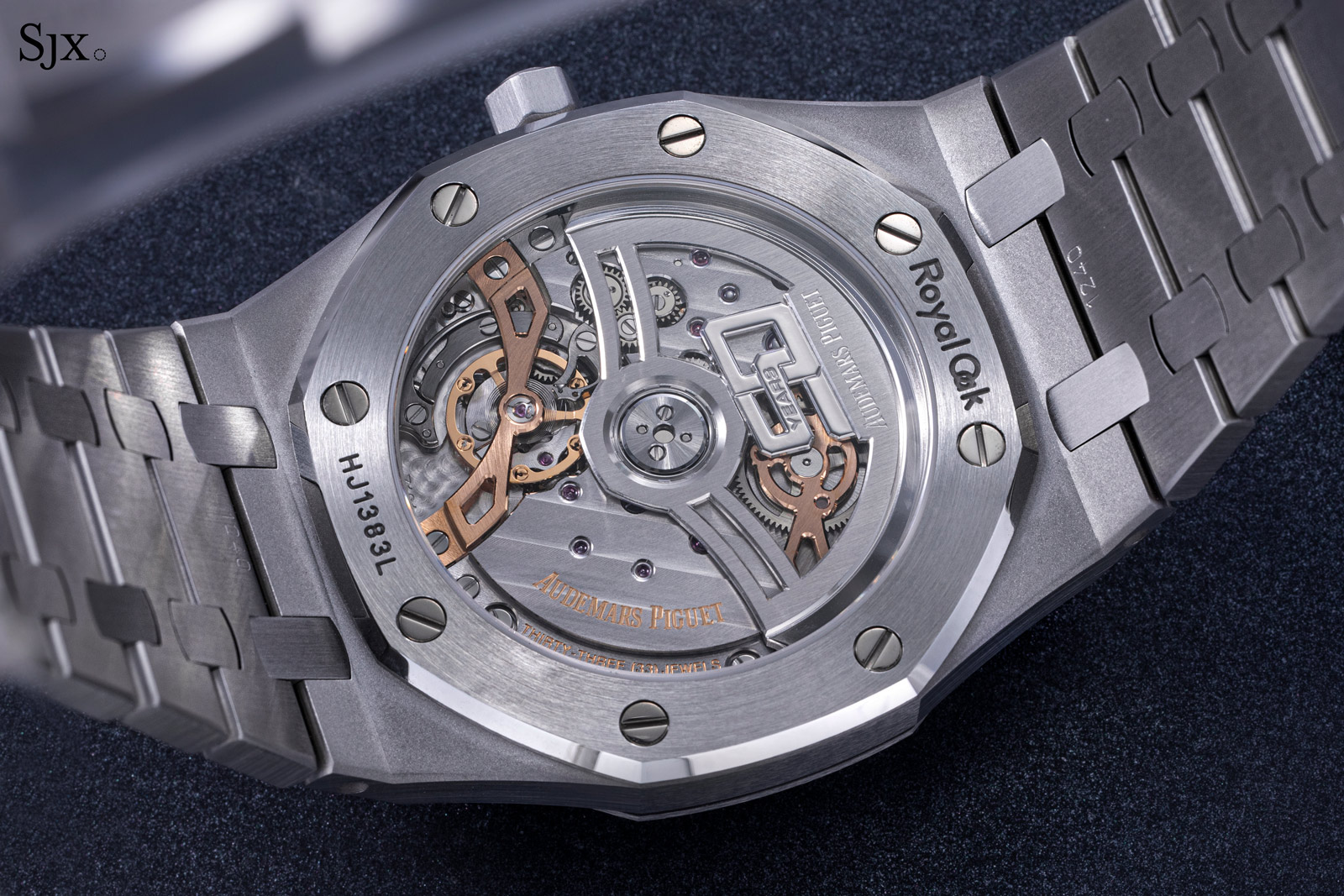
The cal. 7121
The cal. 7121 is every so slightly larger than the cal. 2121, coming in at 29.6 mm in diameter with a thickness of 3.2 mm. In comparison, the cal. 2121 was 28.4 mm wide and 3.05 mm thick. The movement thickness, as well as the revised case construction that has a display back, explains why the new “Jumbo” is 8.1 mm high, compared to the 7 mm of the vintage original.
But the new movement isn’t merely a series of cosmetic tweaks. Its constructors were evidently given carte blanche to build an all-new calibre that can squeeze as much technical goodness as possible into the slim case. The endeavour appears fruitful – almost everything about the cal. 7121 is a technical upgrade over its predecessor.
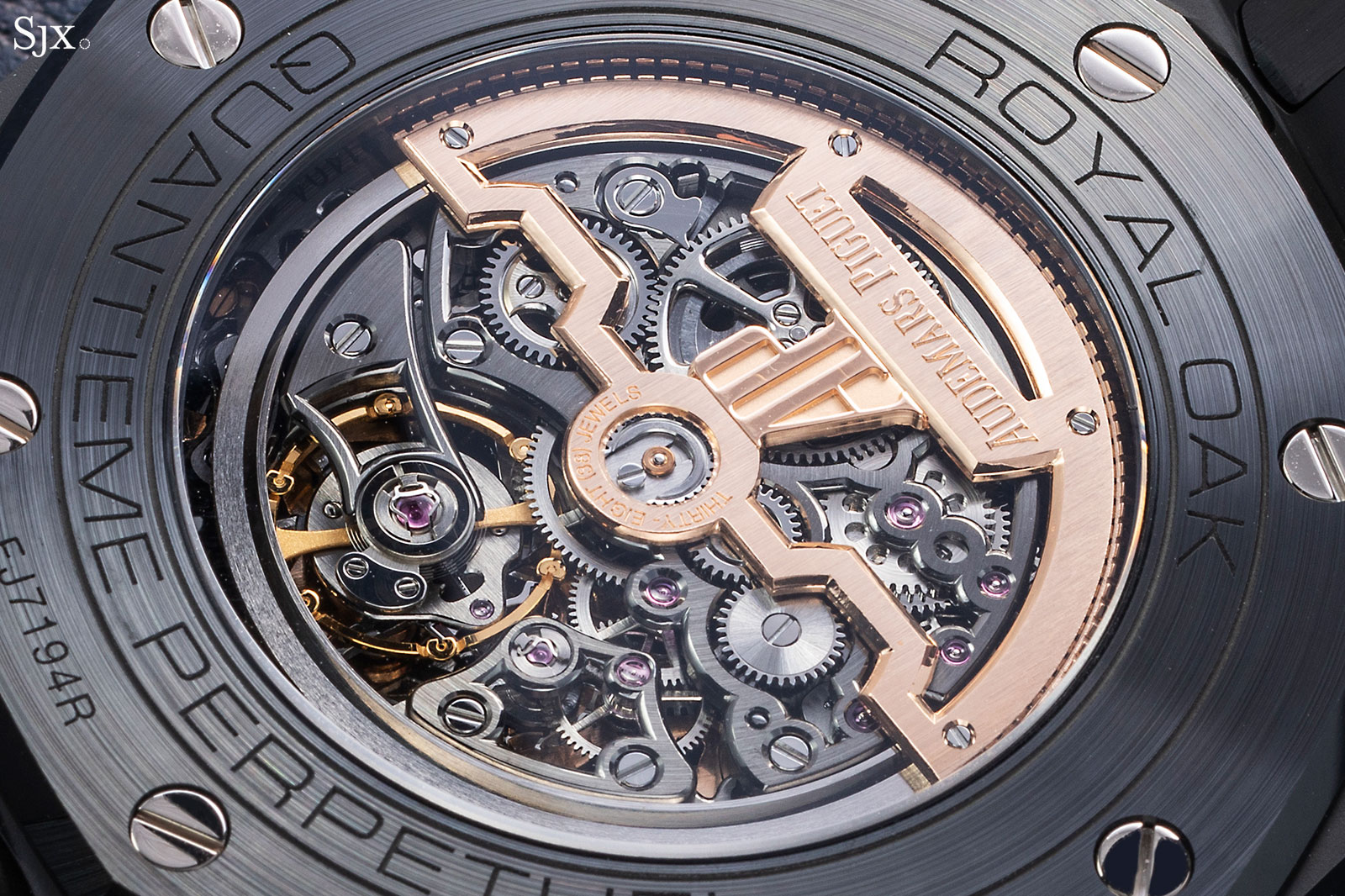
The open-worked version of the cal. 2121
To begin with, the layout of the going train layout is entirely new. The cal. 7121 relocates the entire gear train to the edge of the movement, so the wheels form an arc on the outer edge of the base plate, instead of a typical layout that clusters them in the centre.
As with the cal. 2121, the layout was conceived with thinness in mind – the cal. 7121 was designed to do without a seconds hand, as the fourth wheel is located at seven o’clock, an odd location for a subsidiary seconds if one was installed in the future. To put it simply, it is evident the cal. 7121 was tailored specifically for the “Jumbo” ref. 16202.
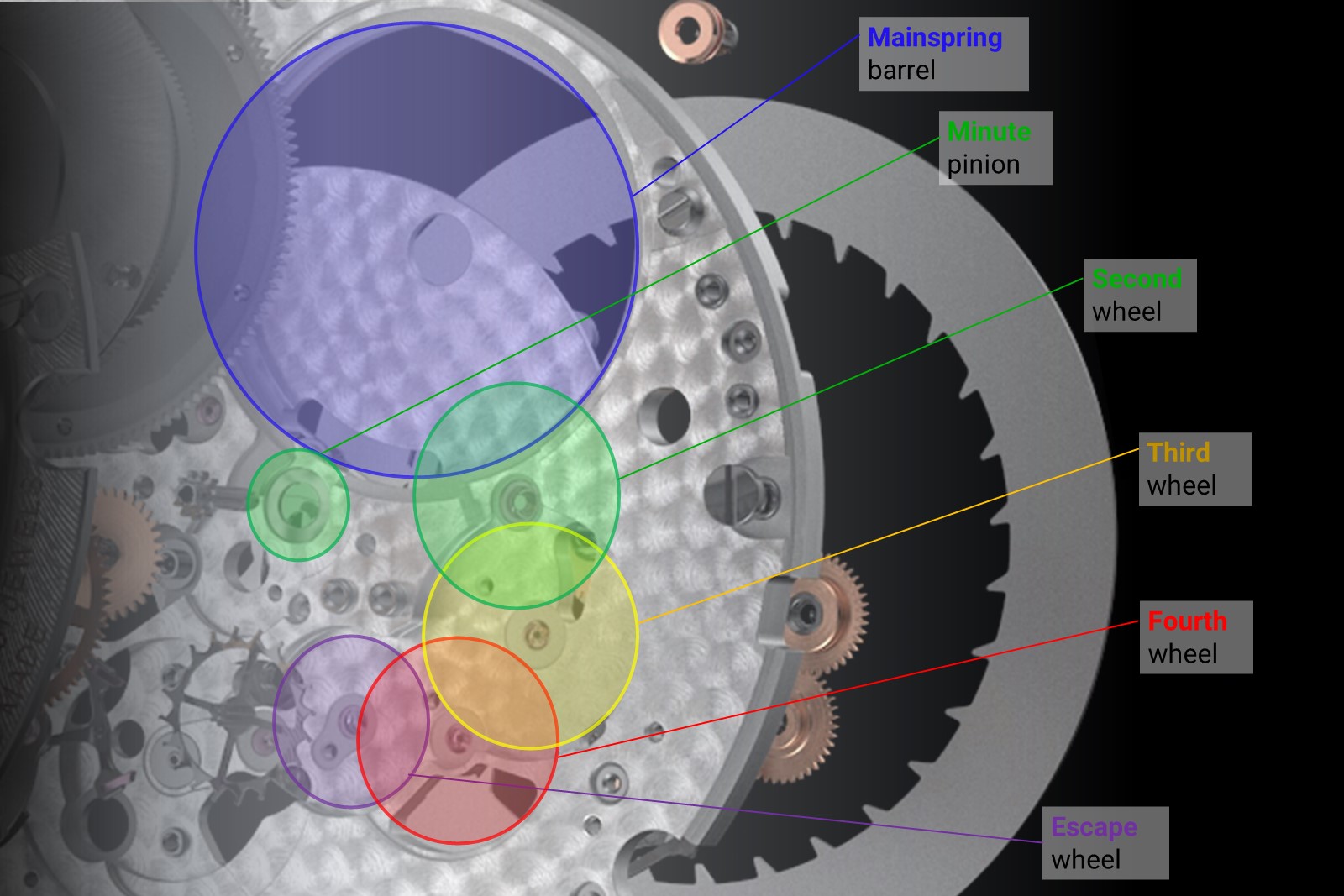
The gear train layout of the cal. 7121
The rationale of this going train layout creates room at the centre of the movement, allowing for a wider mounting for the rotor hub. The increased robustness of the mounting means it can support the winding rotor’s weight on its own, eliminating the characteristic beryllium supporting ring and jewel rollers of the cal. 2121.
Getting rid of the beryllium support ring means frees up real estate within the case, which allows the barrel to be as large as possible. Because it sat a distance from the outermost edge of the movement, the beryllium ring of the cal. 2121 limited the diameter of the barrel, which had to sit within the circumference of the ring.
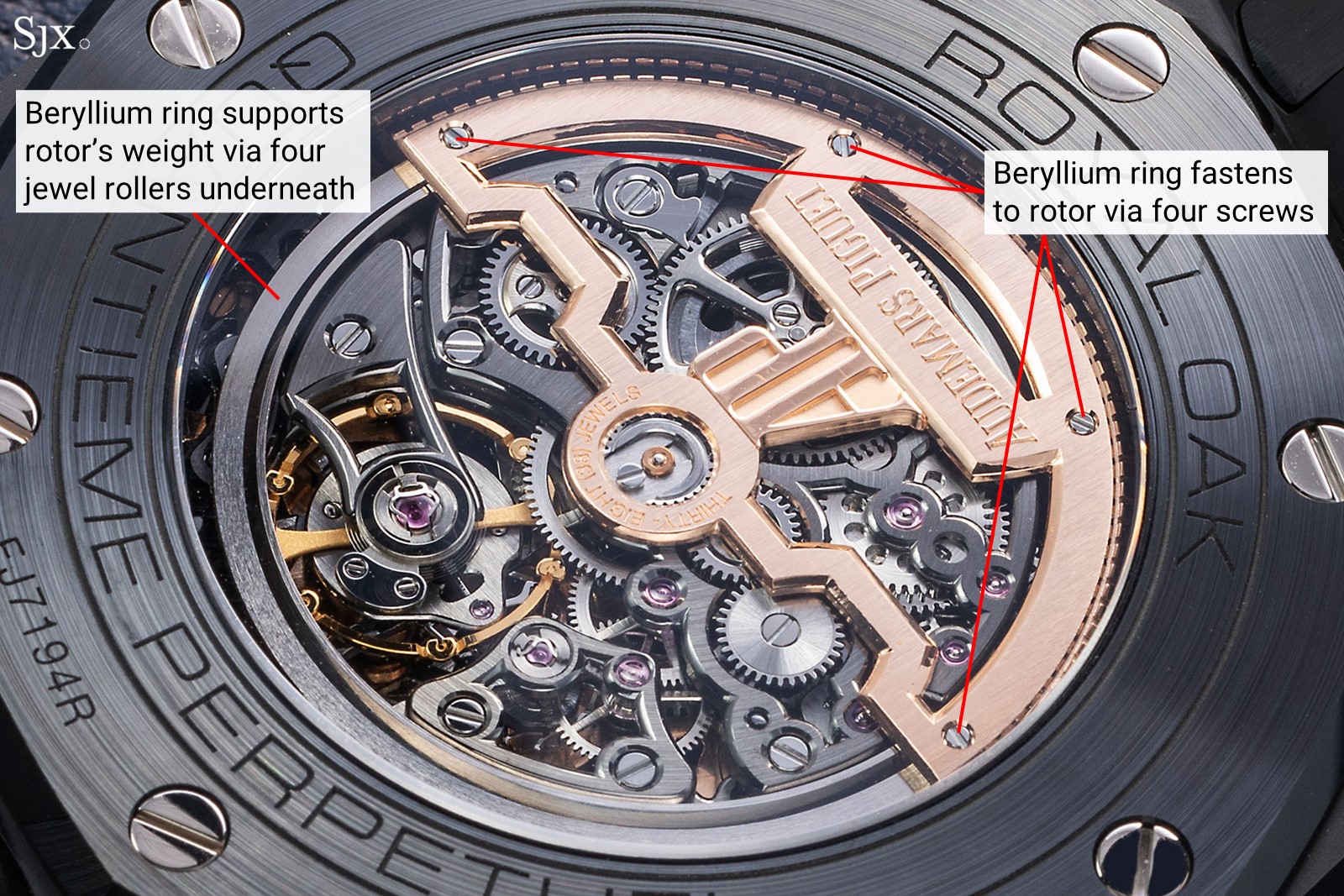
The beryllium ring of the cal. 2121
That is no longer a constraint in the cal. 7121, which has the barrel occupy half the movement’s diameter, going from the centre of the movement to almost the edge of the base plate. The ratio is the ideal in traditional movement construction – it maximises the energy stored within the movement by taking the barrel diameter to the limit; the barrel cannot be any larger due to the pinion at the centre of the movement that drives the minute hand.
That said, the barrel of the cal. 7121 has surprisingly thick walls. In fact, barrel wall is so thick that it even accommodates screws – the barrel cover is fastened via three screws that go into the barrel wall, a decidedly unconventional design.
But that means there is less space within the barrel for the mainspring. This implies that the mainspring stores more energy compared to a traditional mainspring of the same size, so the thick barrel walls serve as a protective capsule to contain the increased torque.
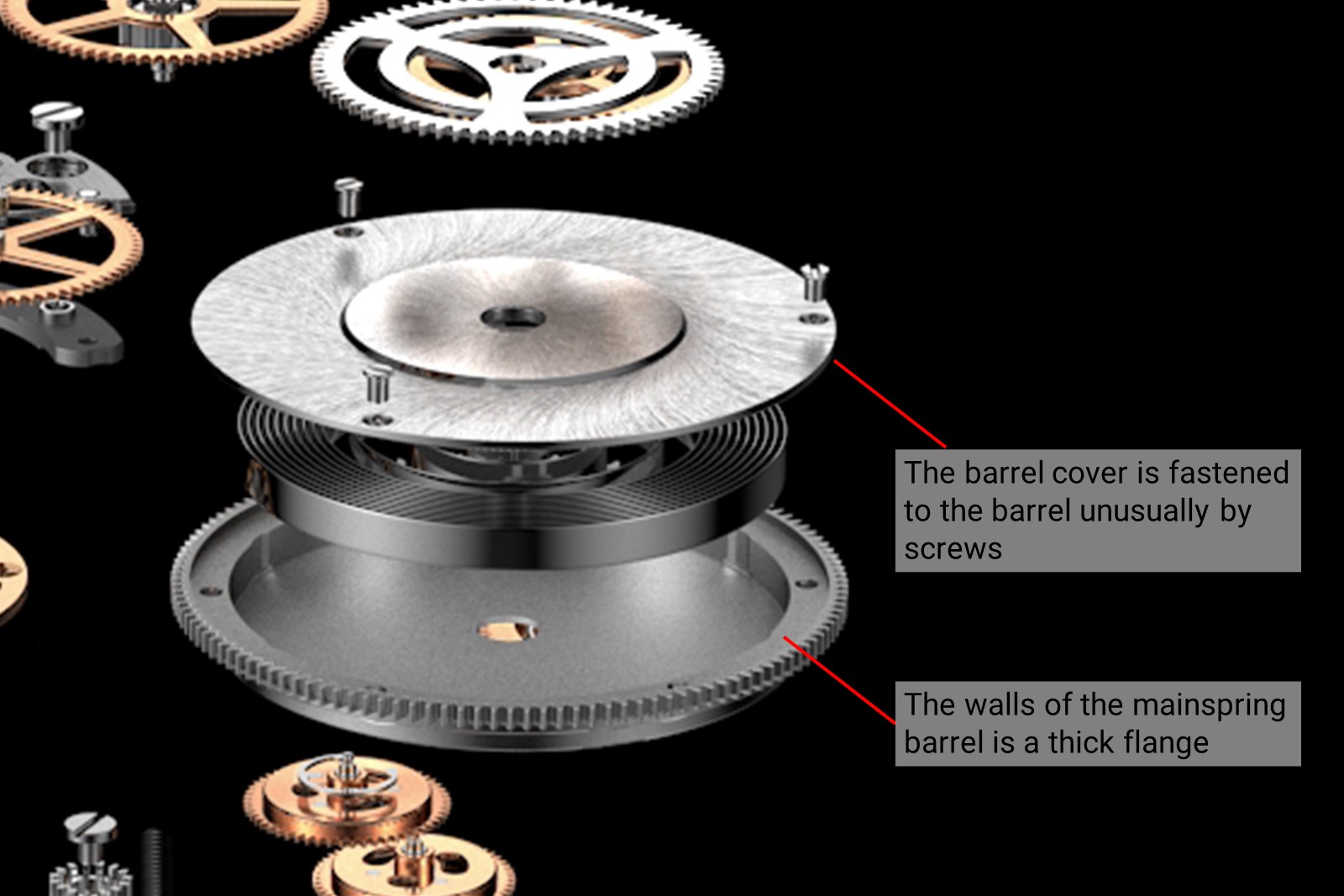
An exploded view of the barrel in the cal. 7121
Symmetry
Unquestionably, aesthetics were a key point in the movement construction, as evidenced by the fanciful, open-worked rose gold bridge that supports the barrel. Three surface jewels are installed around the central pivot of the barrel bridge and almost decorative in their arrange, but they act as contact bearings for the ratchet wheel.
A thoughtful consideration in the movement construction is relatively small diameter of the ratchet wheel, allowing it to sit on the same plane as the second wheel of the going train without overlapping. This is important for thin movements as overlapping the wheels would increase the height of the movement. One can also find a similar design approach in other recent movements from both AP and its peers, such as the AP cal. 4401 and the Patek Philippe cal. 30-255 SC.
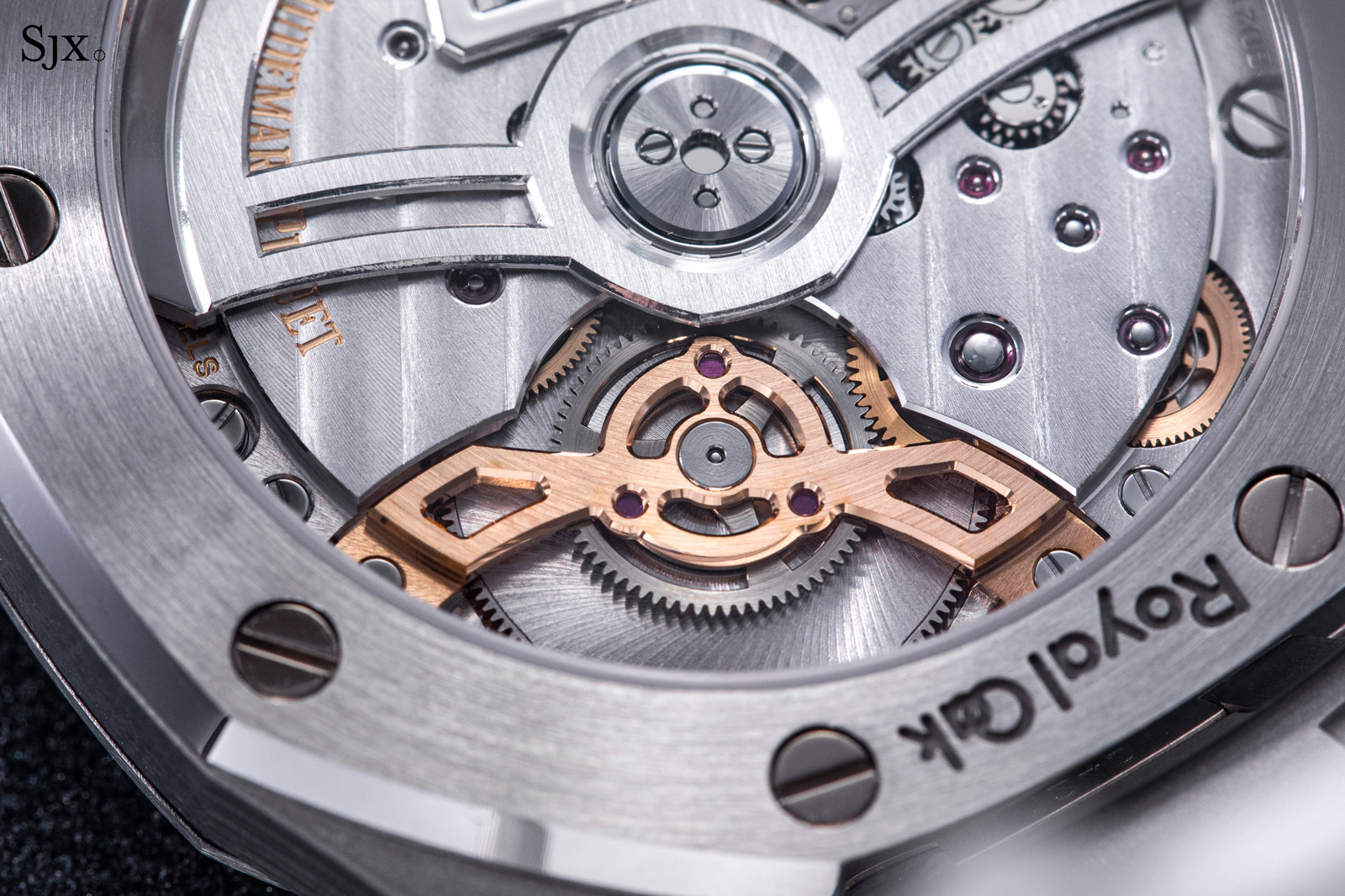
The decorative barrel bridge
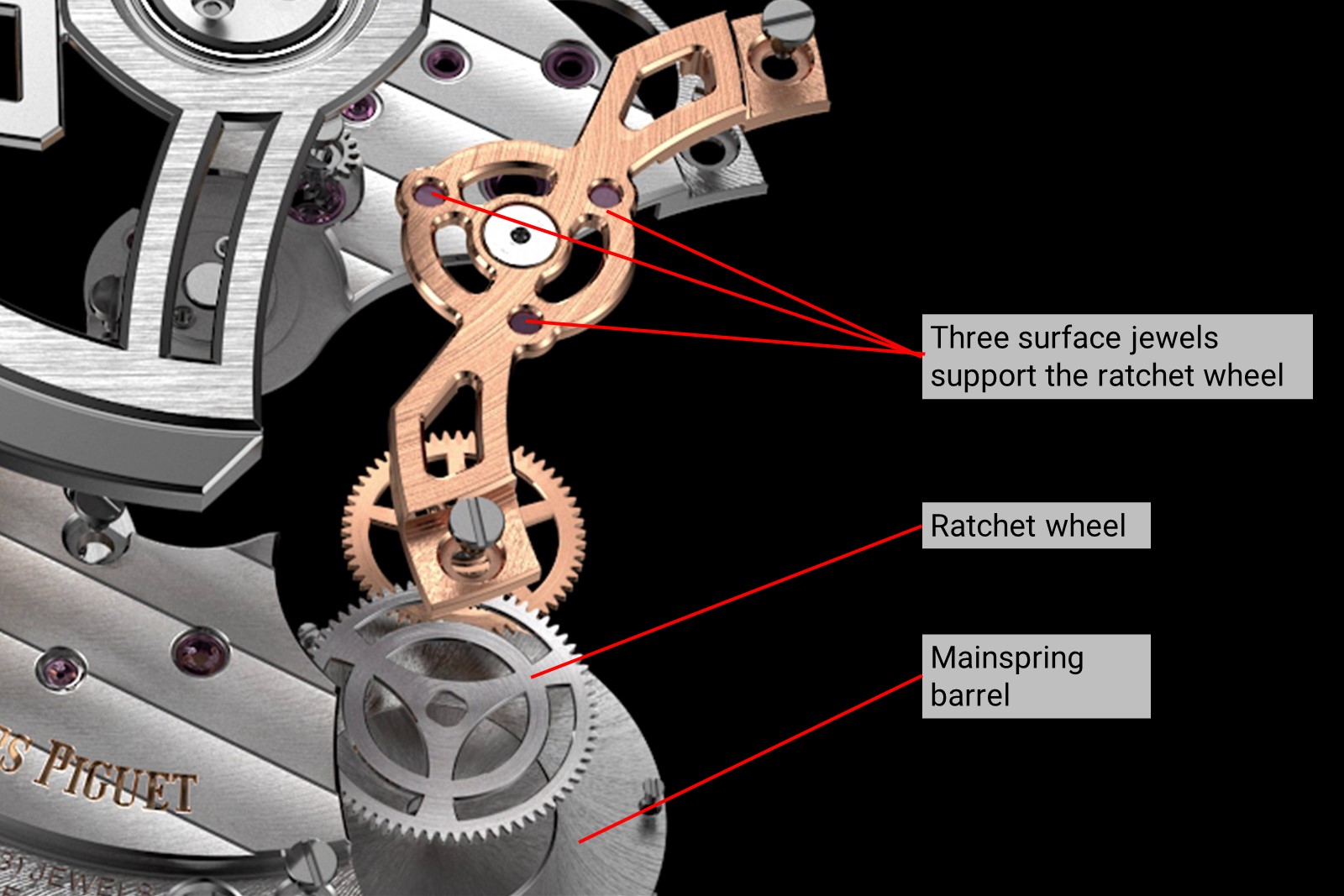
While the skeletonised barrel bridge is unusual – and one might argue over-designed – it is mirrored by an equally unusual balance bridge located on the opposite side of the movement. A full bridge for the balance is not unique in itself, especially in modern movements designed for sports watches, as it provides more stable support for the balance wheel by being anchored on both sides of the balance.
What is unique is the construction of the balance bridge. Specifically, the stud holder for the hairspring isn’t mounted on the balance bridge as is convention. Instead, it sits on a separate bridge adjacent to the balance bridge – a large, curved sliding rack forming an open triangle that’s fastened to the main plate. I cannot think of another modern movement with a similarly offset stud holder.
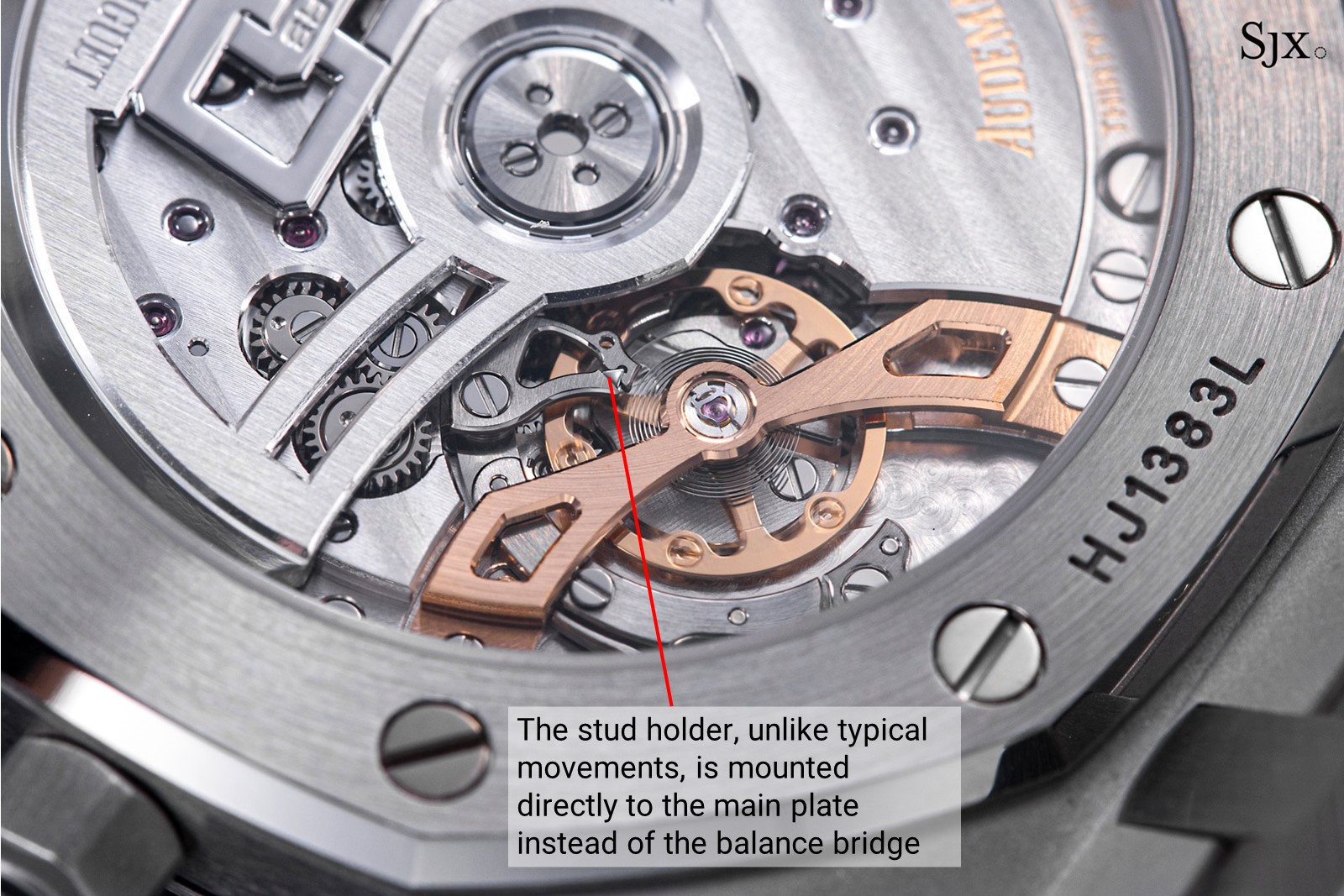
Seemingly over-engineered, the offset stud holder is actually sensible. For one, it ensures that the stud holder will remain firmly in place once adjusted. That matters because correct positioning of the stud holder is important for more regular “breathing” of the hairspring, such that it expands and contracts as consistently as possible in both directions, so that the oscillations of the balance wheel are equally consistent in both direction. This adjustment is known as addressing beat error.
The design makes the stud holder more easily accessible to the watchmaker during servicing, as the balance bridge can be removed entirely without touching the stud holder and disturbing its adjustment.
Also, having the stud holder sitting on a separate structure preserves the thickness and rigidity of the balance bridge, which is surprisingly long and broad for an ultra-thin movement. Having the stud holder on the balance bridge as is the norm would have necessitated cutouts on the underside of the balance bridge to accommodate a pivoting stud holder.
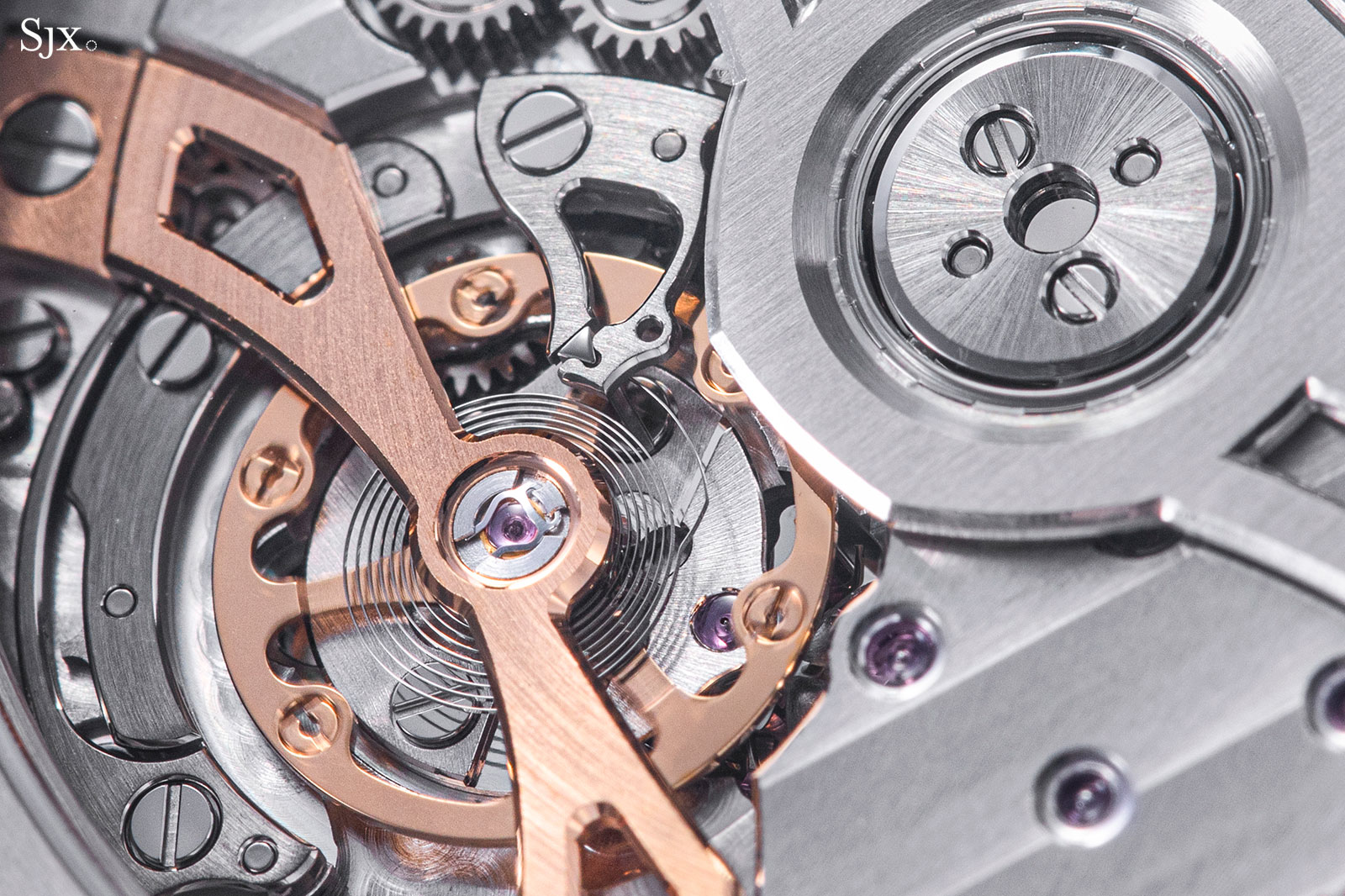
The offset stud holder is surprisingly elegant in form
Equally peculiar is the shape of the balance wheel, which instantly recognisable as a 21st century design and nothing like the Gyromax-style balance of the cal. 2121. It is a free-sprung balance – with six adjustable weights for regulation – and has a smooth rim to minimise air resistance during oscillation.
Notably, the rim is exceptionally wide and flat – wide enough that the weights sit entirely within the rim and flush with its surface – giving the balance the high inertia needed for stable timekeeping. Supporting the weight of the balance may have been another reason for the sizeable balance bridge.
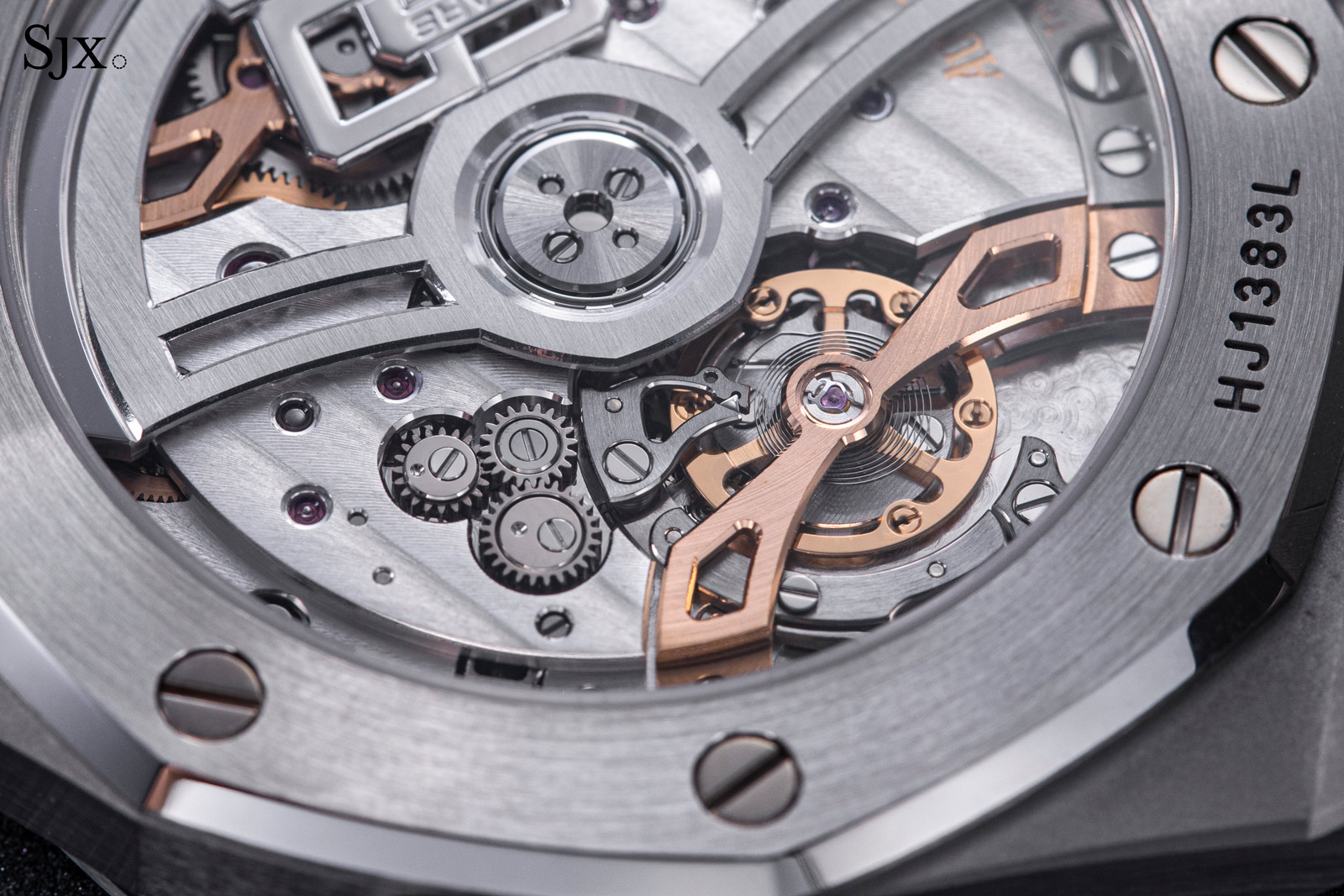
While the design of the balance is almost certainly optimised for good timekeeping, it is too industrial in terms of aesthetics. The balance appears out of place in a high horology context, especially considering it is the focal point visually – the big gold bridge makes it hard to miss. But the appearance is understandable and perhaps necessary in a tradeoff for better chronometric performance.
In theory, the cal. 7121 should perform very well in that respect – the balance wheel is relatively large and beats at the modern standard of 4 Hz. This is an upgrade over the slow-beat cal. 2121 that ran at a languid 2.75 Hz, a quaint frequency rarely used today.
A higher beat is desirable in most movements, but especially for one in a sports watch, as it means the oscillations of the balance are less susceptible to external disturbances such as shock or erratic motion of the wrist.
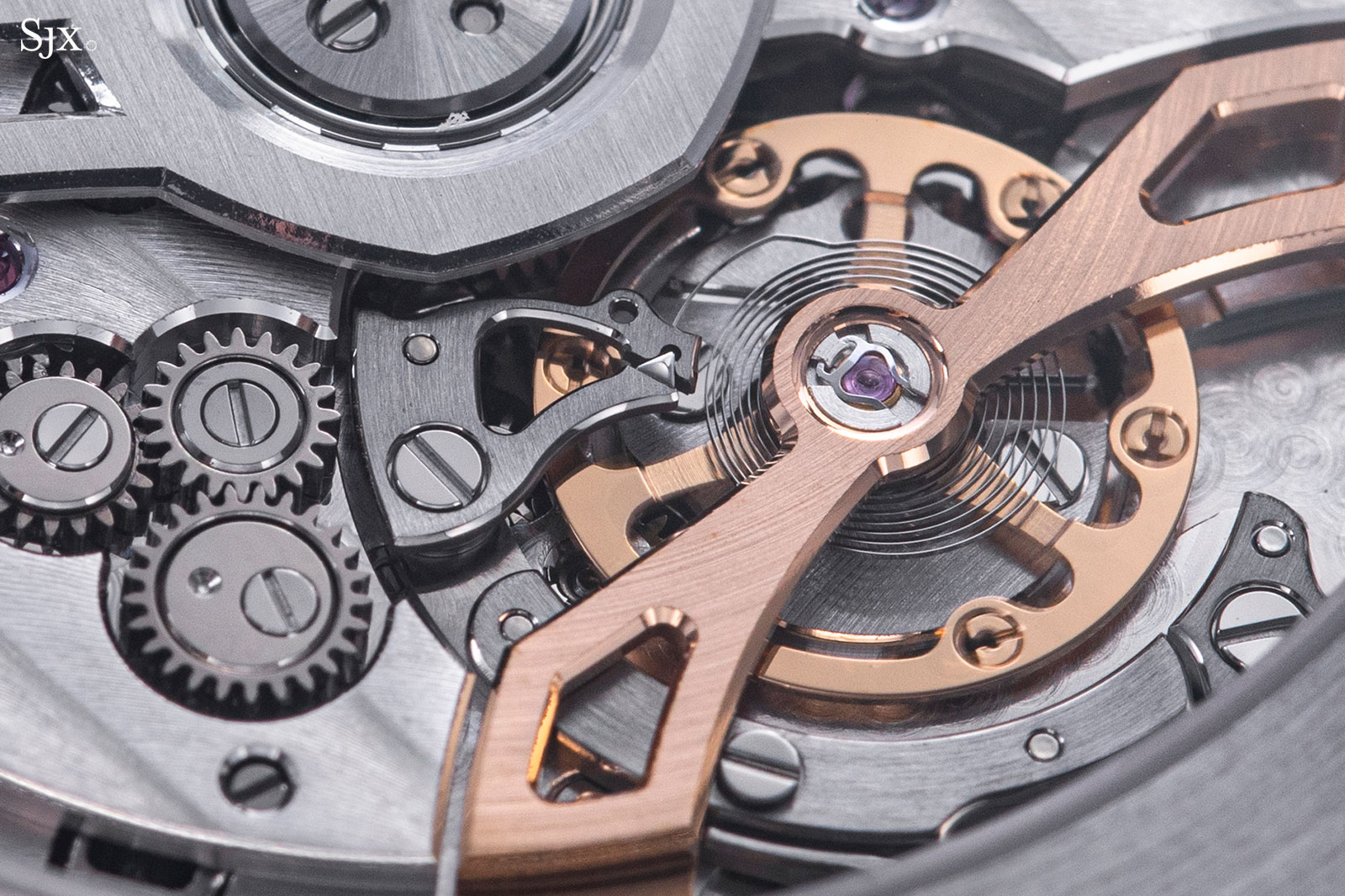
The three-armed balance with its wide rim and equally wide arms
Bidirectional winding
Another major upgrade lies in the automatic winding system. Besides the reinforced rotor hub, the cal. 7121 employs a more complex, bi-directional winding mechanism that replaces the uni-directional winding found in the cal. 2121.
Uni-directional compared to bi-directional winding is commonly debated, but the undeniable fact is bi-directional systems are more complicated as they require more components and therefore occupy more space (save exceptions such as Seiko’s “Magic Lever”). In a thin movement like the cal. 7121, the incorporation of a bi-directional winding mechanism is a noteworthy – even more so considering the space taken up by the large barrel and balance wheel.
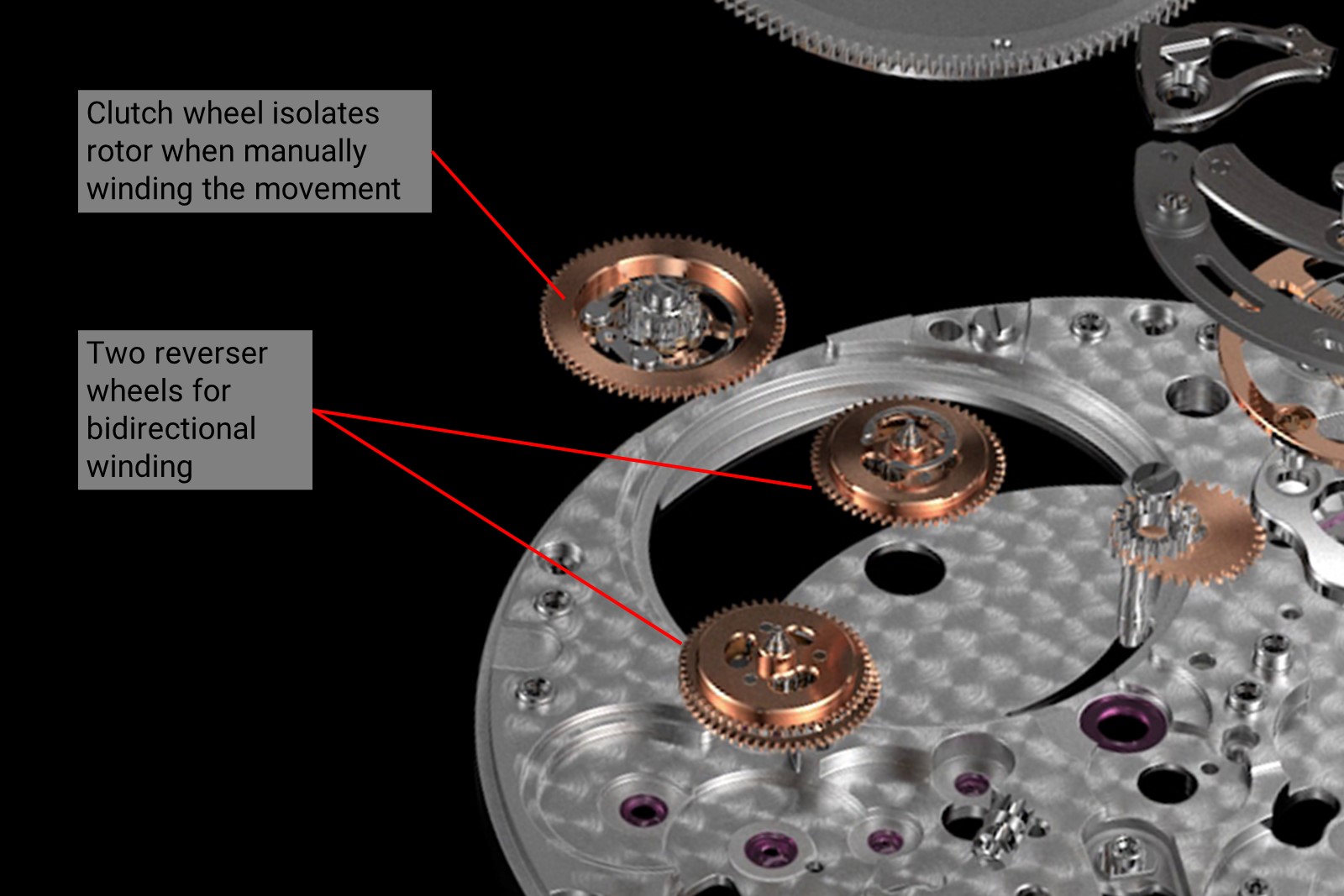
The winding gears
In the cal. 7121, the set of reverser wheels sit next to the mainspring barrel, hidden under the barrel bridge. They are laid out such that space remains for the wheels needed to wind the mainspring manually via the crown.
In short, almost every square inch of space in the movement has been fully utilised, making the cal. 7121 a highly efficient construction.
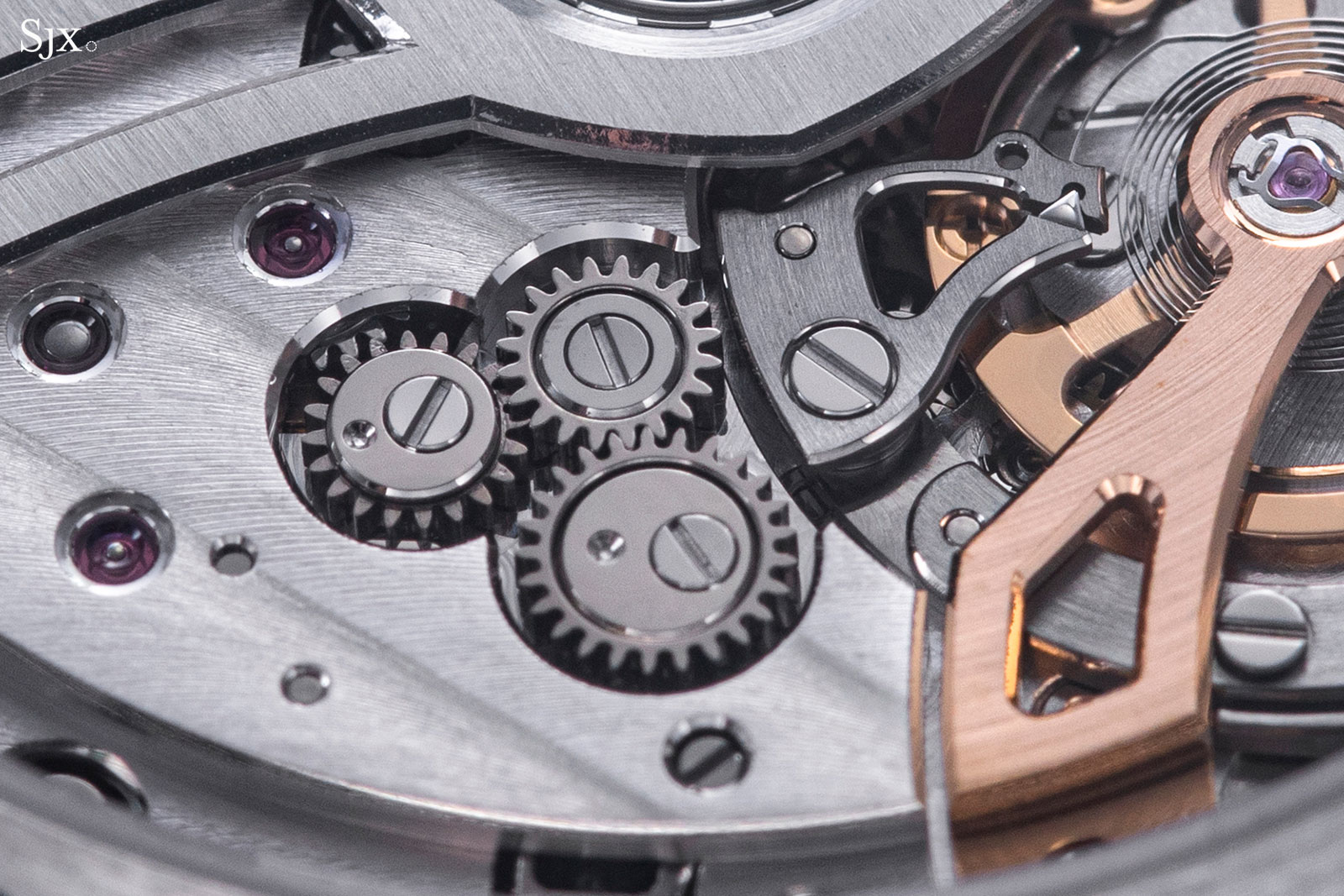
The trio of intermediate wheels that enable hand winding via the crown
Quickset, finally
And last but not least, the cal. 7121 has a feature that’s the most practical amongst all its upgrades – a quickset date.
Owners of past “Jumbo” models including the ref. 15202 will appreciate the quickset date as the cal. 2121 found in earlier generations dictated a painstaking process to set the date: adjusting the time back and forth past midnight repeatedly, advancing the date one day at a time.
It was forgivable given that the cal. 2121 was a 1960s construction old, a period when quickset-date mechanisms had yet to become ubiquitous. More pertinently, the quickset was likely impossible due to space constraints in the architecture of the cal. 2121.
With the quickset feature, the date on the cal. 7121 can be advanced rapidly, as is expected in a modern watch. A glance at the movement schematics makes it clear that a quickset date was a priority during construction as the date mechanism is integrated into the base plate, instead of simply being tacked on as a module.
Like its predecessor, the cal. 7121 has an instantaneous date display that changes around midnight. However, it relies on an intriguing setup to do that, for which a patent was filed, EP3584643B1.
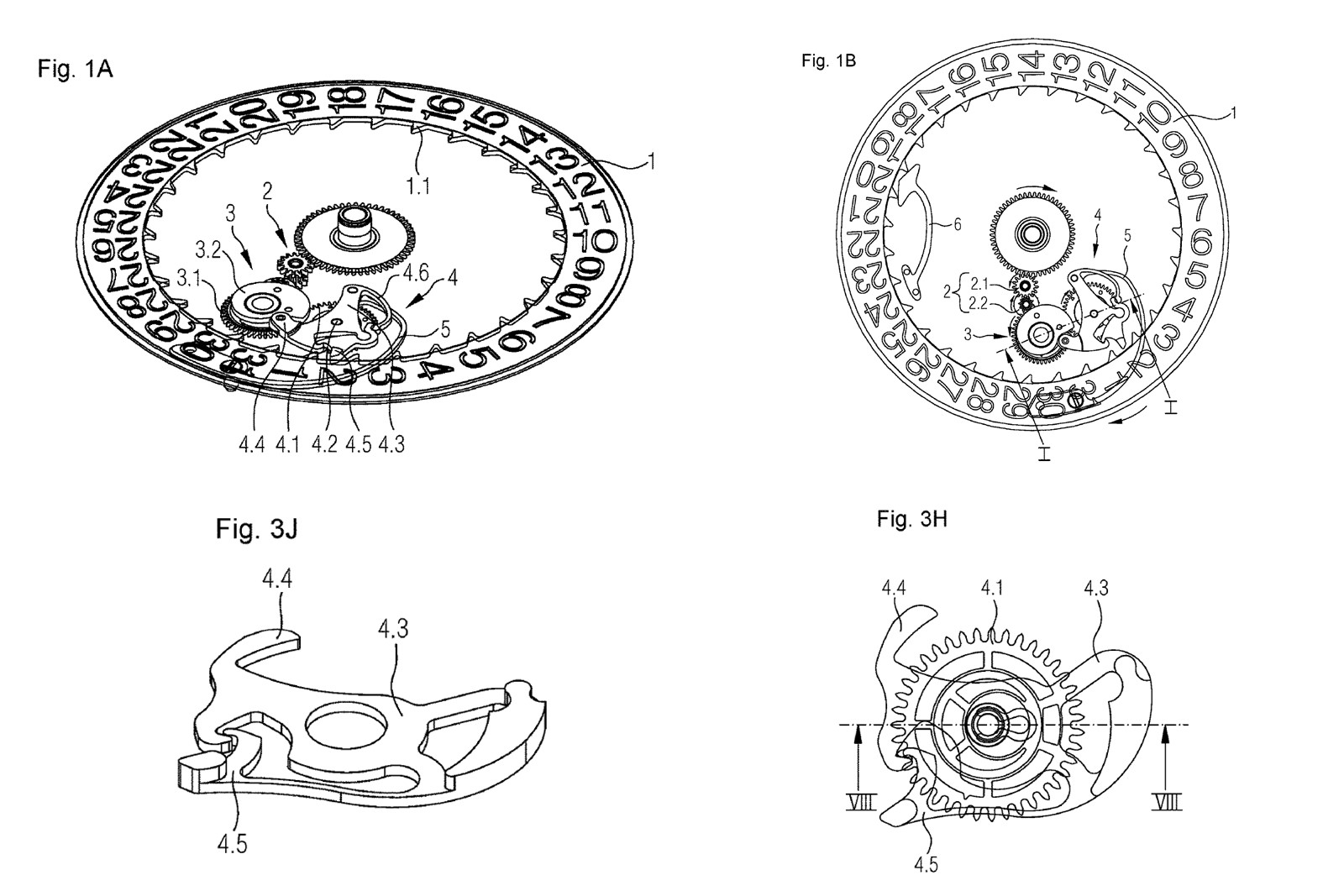
An excerpt from European patent EP3584643B1 detailing the key components of the instantaneously jumping date mechanism
The key component of the instantaneous date is the flexible finger seen above in Fig. 3J. The finger is mounted on a 24-hour wheel that has an eccentric centre that causes the wheel to “wobble” as it rotates. Due to this eccentricity, the finger gradually compresses against an adjacent snail cam, serving as a spring that slowly builds up the energy needed to facilitate the jump at midnight.
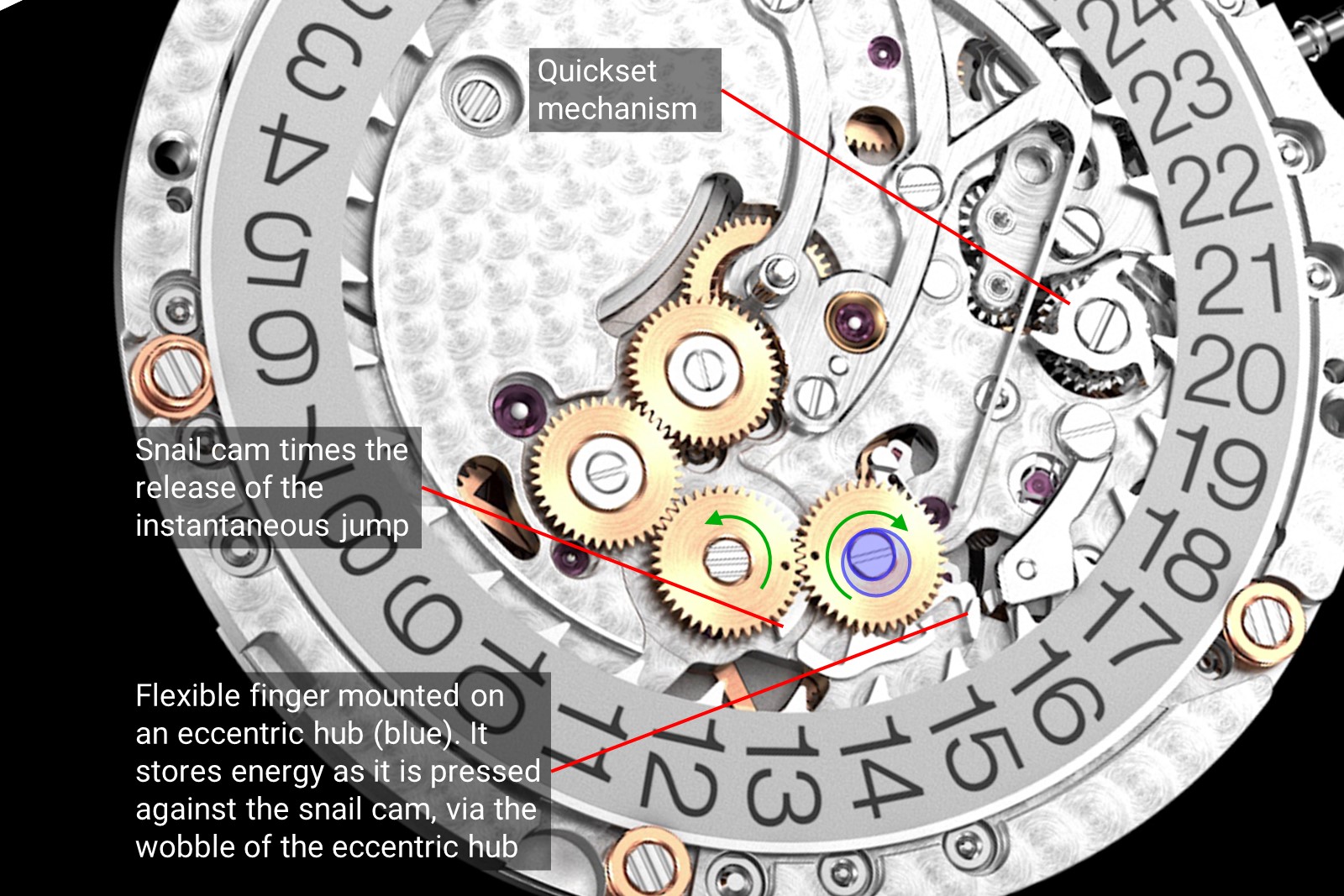
The patent cites this design as having the advantage of allowing for a gradual build-up of the energy needed for the date jump over 24 hours, avoiding the spike in energy consumption typically required for an instantaneous jump around midnight. Another benefit of the flexible finger design is the ability to set the date at any time, even around midnight, without damaging the components due to the elasticity of the parts.
In summary, the movement is technically accomplished – the dimensions of the cal. 2121 were more or less preserved, but the volume within was used more efficiently, with no space left occupied. There’s much to appreciate in the cal. 7121, from both a technical and practical standpoint.
Crucially, the escapement has been redesigned to meet modern standards of chronometry. At the same time, the rotor is now supported by its hub alone, doing away with the beryllium ring that long defined the cal. 2121. And lastly – and most importantly for an owner of the ref. 16202 – is the addition of a novel, patented quickset date.
Finishing
On top of the technical upgrades, AP has given the cal. 7121 a contemporary aesthetic that is more visually interesting. The movement retains many of the decorative elements expected of a movement in this price segment. For example, the bridges are decorated with uniform Côtes de Genève, while the screw and jewel holes have countersinks that have been cleanly mirror polished to remove machining marks.
And as expected of a movement in this price segment, all parts are properly attended to, even those that are barely visible. The steel stud holder, for instance, is straight grained on top and mirror polished – by hand – on its bevels. And the pallet lever bridge below the balance is similarly straight grained on its top, but bevelled in a CNC machine.
[NB: The example pictured here is a travelling sample that is not for sale, so the movement is not perfectly clean.]
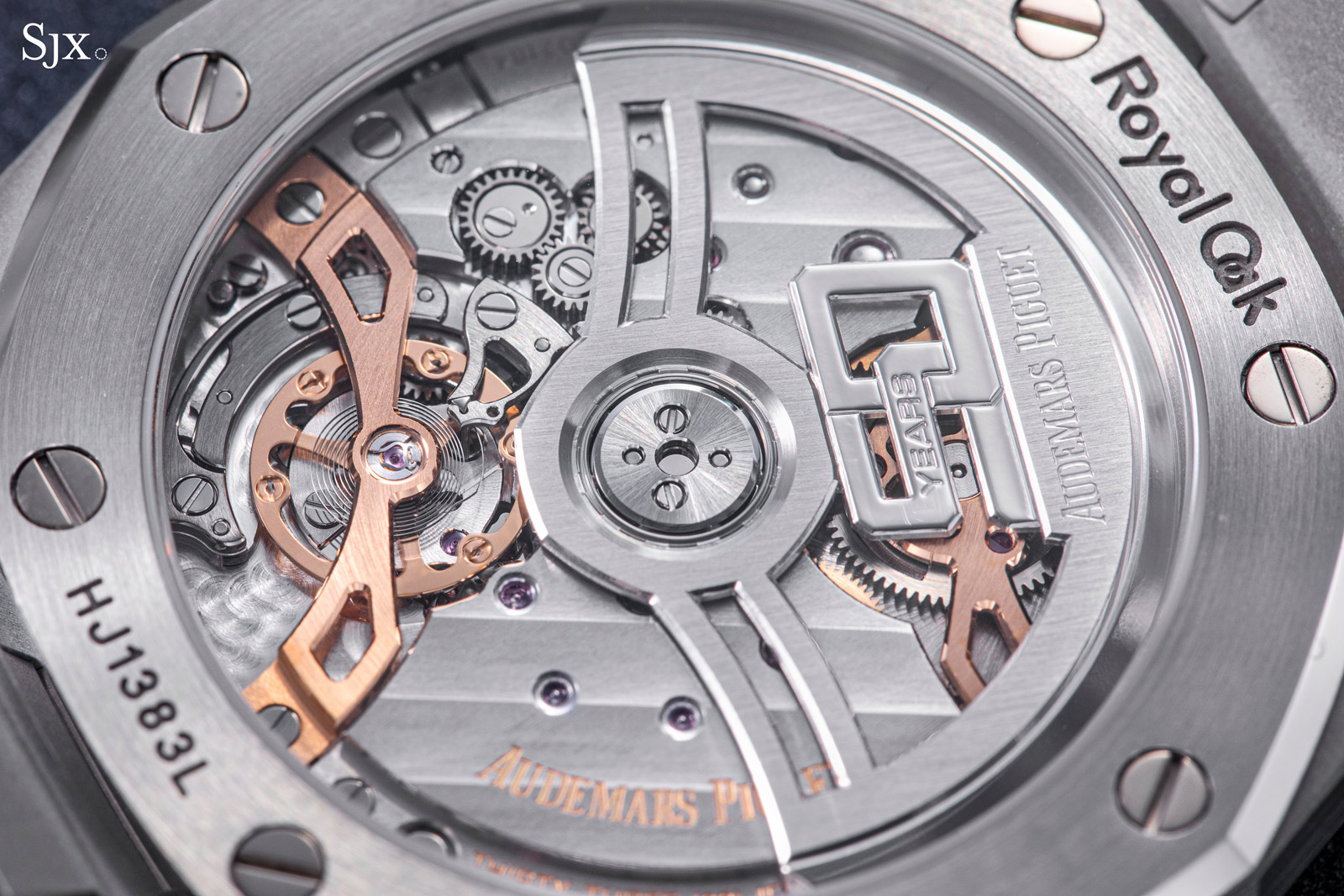
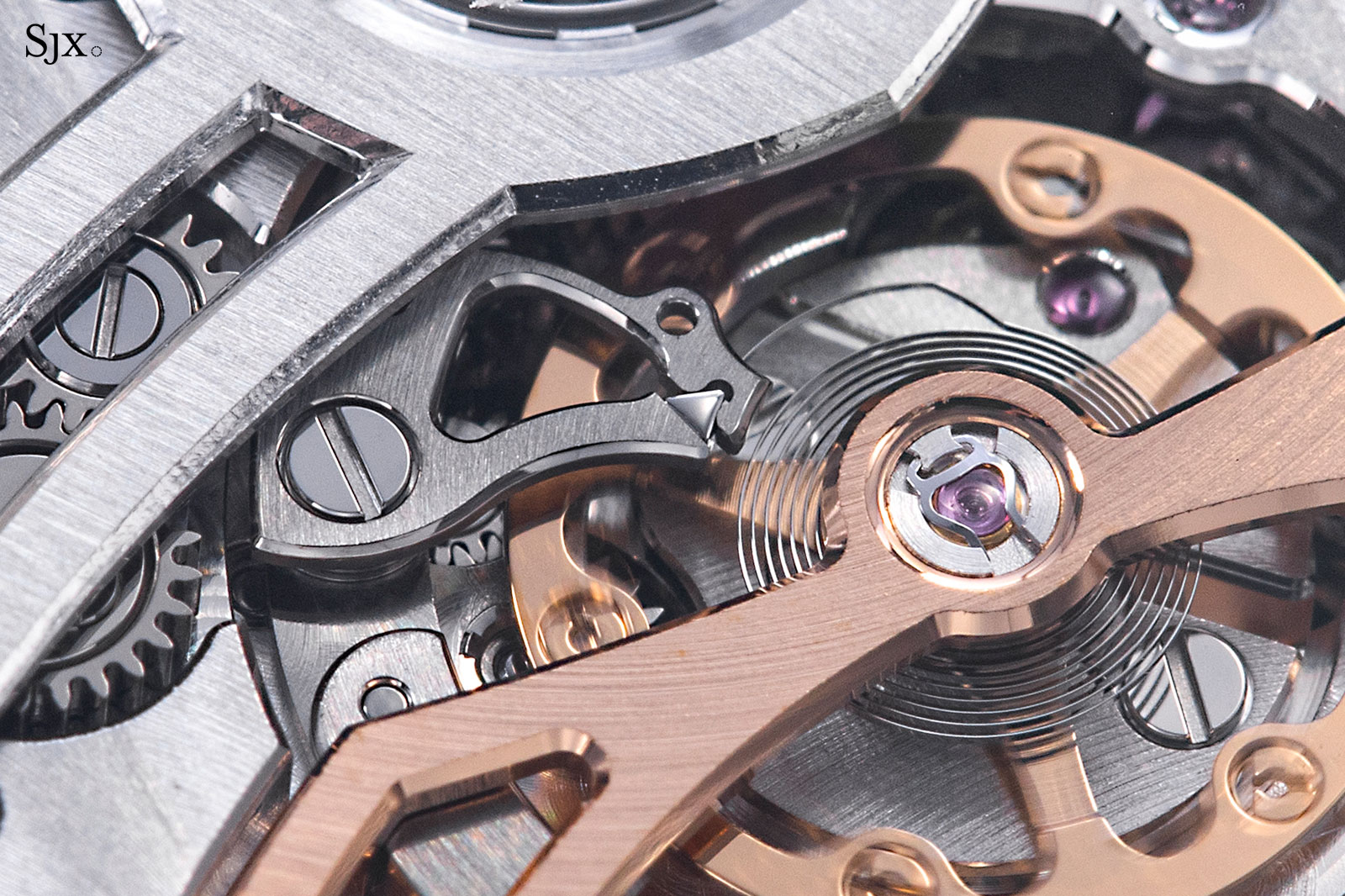
Notice the finish of the stud holder and pallet lever bridge; the bevelling on the stud holder is done by hand, while that of the balance bridge is done by machine
One quibble, however, is the diamond-cut anglage on the bridges. This type of bevelling is done with a CNC machine and has long been a trademark of AP movements, though it is found in most modern-day calibres across the industry.
While still visually coherent, especially given the modern aesthetic, the bevelling lacks the charm of hand-applied anglage evident on the cal. 2121 that was evidently done by hand due to the rounded profile of the bevels.
That said, the execution of the twin gold bridges is especially attractive, which is helpful since they are visual highlights. The wide and reflective diamond-cut bevels complement the symmetrical, skeletonised bridges and create an appealing visual balance between the bevel width and bridge shape. The bevelling of the gold bridges is also complemented by the neatly brushed surfaces, especially on the barrel bridge that contrast well with the sun-ray finish on the barrel cover underneath.
In comparison, the bevelling is less pronounced on the rhodium-plated bridges due to their thinness and width. The large bridges are a consequence of the enlarged movement diameter compared to the cal. 2121 and also the removal of the beryllium ring.
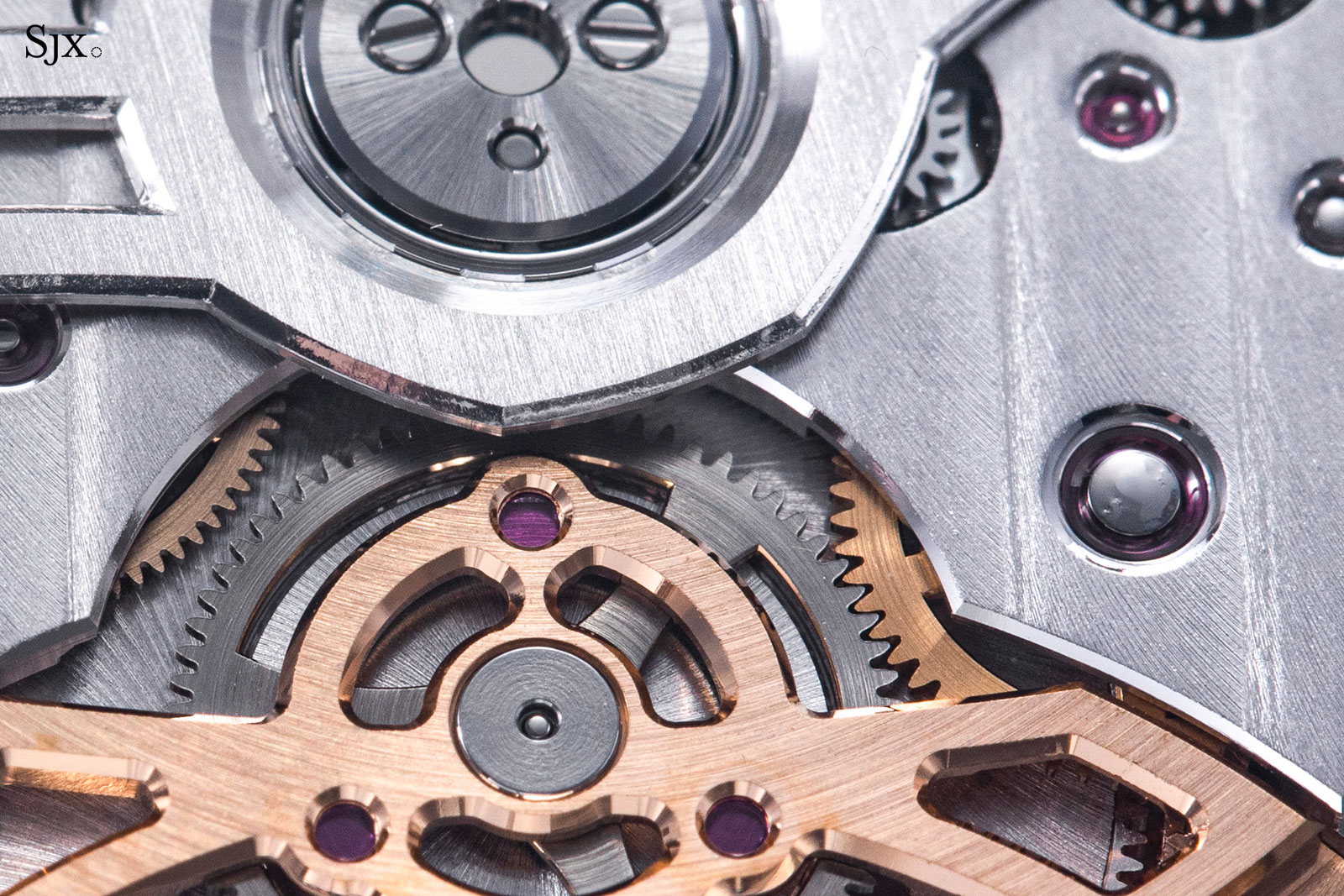
The barrel bridge next to the rotor hub
“50 Years” big and bold
And then there’s the obvious: a large rotor with the Royal Oak 50th anniversary emblem. This single component is probably the most polarising due to its bold, contemporary design that leaves it seeming overdone largely as a result of the “50 Years” logo that’s done in a stylised, angular font.
I would have preferred a design that echoes to the radial form of the rotor, such as the coat of arms on the rotor of the AP cal. 3120. But fortunately for anyone who doesn’t like the rotor design, the “50 Years” rotor will only be available in 2022. From next year onwards the cal. 7121 will be fitted with a standard rotor that’s presumably similar to that found on recent Royal Oak movements.
However, the rotor bearing hub is tastefully done and ringed by an octagonal form – an element that obvious yet subtle. The rest of the rotor is open-worked generous, creating an airy appearance that provides a good view of the movement below.
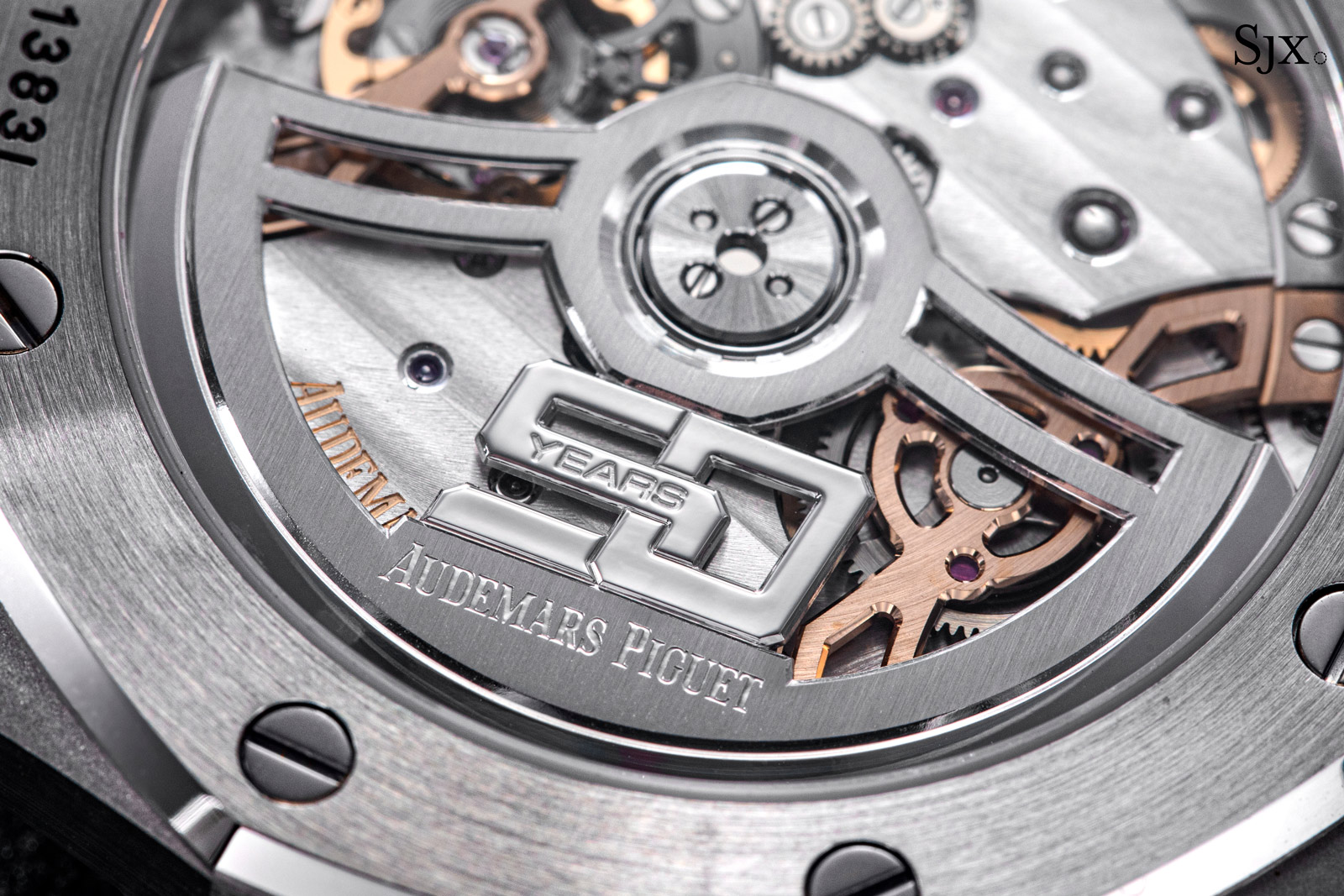
While aesthetics of the rotor are debatable, the finishing is undeniably good. In fact, the rotor is more elaborately finished than the movement bridges. The anglage of the rotor is polished by hand, as evidenced by the 14 inward angles. Such anglage is executed with a hand-held, motorised drill mounted with a tiny burr, which inevitably leads to a slight unevenness around the inward angles. Still the manual effort required is appreciated over straightforward machine finishing.
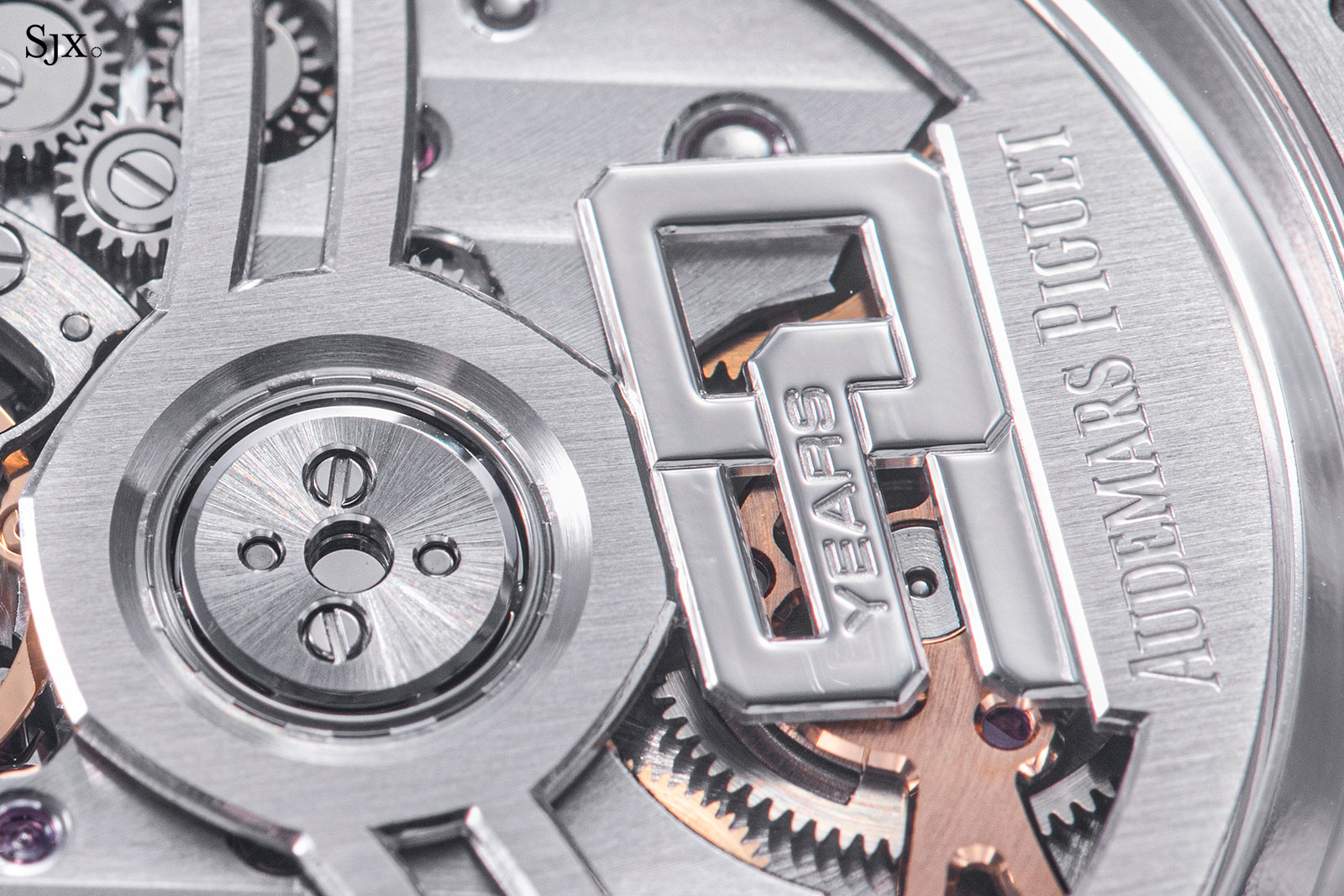
The rest of the rotor is notably well-executed with neat, linear brushing on its top that contrasts against the mirror-polished “50 Years” logo that’s presumably polished chemically due to the fact that it’s integral to the rotor.
Despite the entire rotor being a single part, the mix of finishing techniques make it interesting. The rotor will be matched with the colour of the case, so the steel model pictured here has a white gold rotor, while the yellow gold variant will feature a yellow gold rotor.
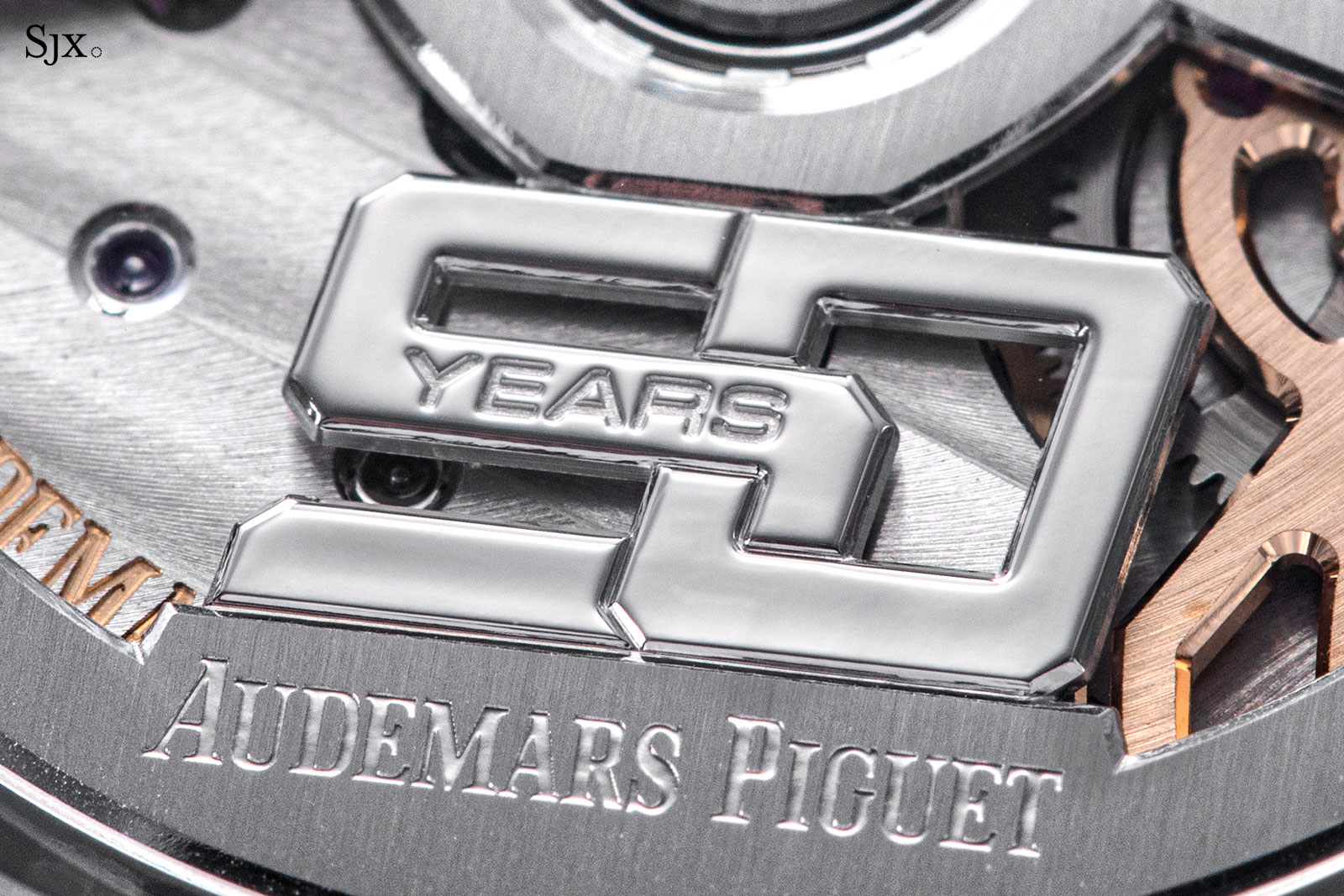
Overall, the cal. 7121 is a refreshing update to the cal. 2121 that is some 50 years old. With its rose gold bridges and open-worked rotor, the movement is striking. But more importantly, it is more accomplished in technical terms than comparable movements such as the Patek Philippe cal. 26-330 SC and the Vacheron Constantin cal. 5100, a considerable feat given the thinness of the movement.
Still, the cal. 7121 doesn’t quite match the L155.1 found in the Lange Odysseus in terms of decoration. Like all Lange movements, the L155.1 is enhanced with flourishes such as blued screws and a gold chaton that provide contrast, along with artisanal touches like the hand-engraved balance bridge, as well as the bonus of a platinum-rimmed rotor.
The L155.1, however, is a far thicker and also less inventive in its construction. The cal. 7121 manages to be substantially thinner while taking a novel, creative approach to construction as illustrated by the offset stud holder or thick-walled barrel. It is a smart, accomplished movement that is amongst the best in contemporary watchmaking.
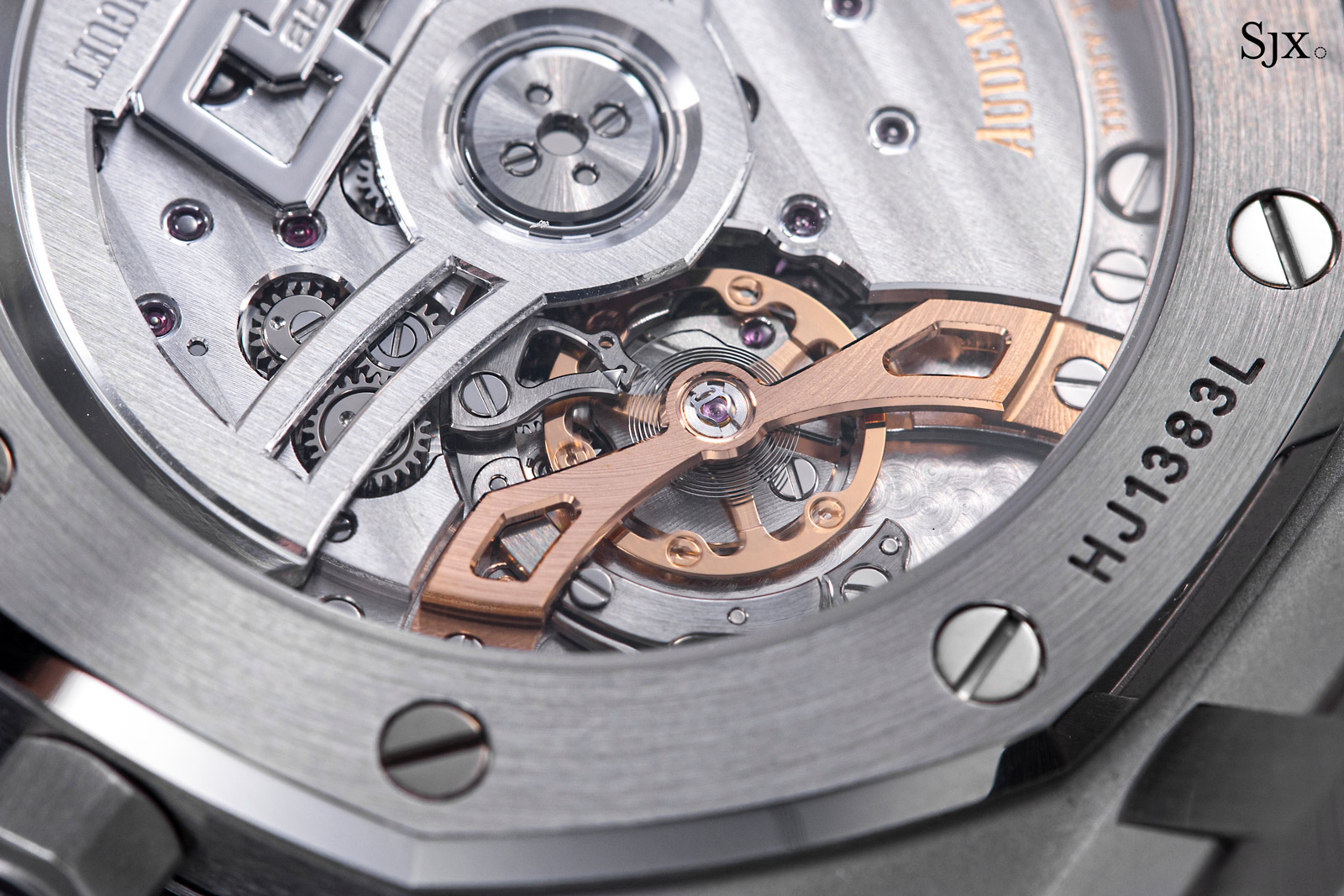
Concluding thoughts
The new “Jumbo” is a perfect upgrade of the original that preserves its key characteristic while refining everything that needed improving, ranging from the bracelet to the movement. Even though the varied improvements are individually minor, together they are greater than the sum of the parts.
It’s difficult to conceive of a “better” version of the Royal Oak “Jumbo”. Granted the movement finish could be more artisanal, but that would not be viable considering the price – which makes the “Jumbo” perhaps even a value proposition. Getting one at retail is another matter altogether, but the ref. 16202 is intrinsically an excellent timepiece.

Key facts and price
Audemars Piguet Royal Oak “Jumbo” Extra-Thin 39 mm
Ref. 16202ST.OO.1240ST.01 (steel)
Ref. 16202OR.OO.1240OR.01 (pink gold)
Ref. 16202BA.OO.1240BA.01 (yellow gold)
Ref. 16202PT.OO.1240PT.01 (platinum)
Diameter: 39 mm
Height: 8.1 mm
Material: Steel, 18k yellow gold, 18k pink gold, or platinum
Crystal: Sapphire
Water-resistance: 50 m
Movement: Cal. 7121
Functions: Hours, minutes, and date
Winding: Automatic
Frequency: 28,800 beats per hour (4 Hz)
Power reserve: 55 hours
Strap: Matching bracelet
Limited edition: No
Availability: At all boutiques but the platinum version is only available at AP Houses
Price:
Steel – US$33,200, or 47,900 Singapore dollars
Pink gold and yellow gold – US$70,500, or 101,800 Singapore dollars
Platinum – US dollar price unavailable; 164,700 Singapore dollars
For more, visit audemarspiguet.com.
Back to top.








